Special Report
The School District Where Students Are Most Likely to Succeed in Every State
Published:
Last Updated:
School district quality is one of the most important factors homebuyers consider when looking for a place to live — particularly for new or expecting parents. A good school district can greatly increase a child’s chances of future success.
Of course, the influences that can shape a child’s future are not strictly limited to the classroom. Conditions in the home and the broader community also have an effect.
Using data from the U.S. Census Bureau and the National Center for Education Statistics, 24/7 Wall St. developed an index of measures, including the child poverty rate, the teacher-to-student ratio, per-pupil spending, the share of adults with a college education, and the high school graduation rate to determine the school district where students are most likely to succeed in every state. In our analysis, we also reviewed a number of measures of district outcomes, including college entrance exam performance and subject proficiency tests from education and community data clearing house, Niche. While favorable rankings in these measures will not alone ensure children’s chances for success through their school years and into adulthood, they can provide them with considerable advantages.
One of the most important predictors of a child’s academic success is their poverty status. Children living below the poverty line are more likely to report poor physical health and have reduced ability to concentrate and retain information. Childhood poverty increases the likelihood of low test scores and reduces a student’s chances of completing high school. For this reason, the child poverty rate was selected as a component in the index. Here is a state-by-state look at the child poverty rate.
It is important to note that education policy is decided largely at the state level, and partially as a result, the difference in school district quality across a state can be lower than it is between states. A district that ranks as the best in a given state will not necessarily rank favorably among districts in other states. Here is a list of the states with the best and worst schools.
Click here to see the school district where students are most likely to succeed in every state
Click here to see the school district where students are least likely to succeed in every state
Click here to read our methodology
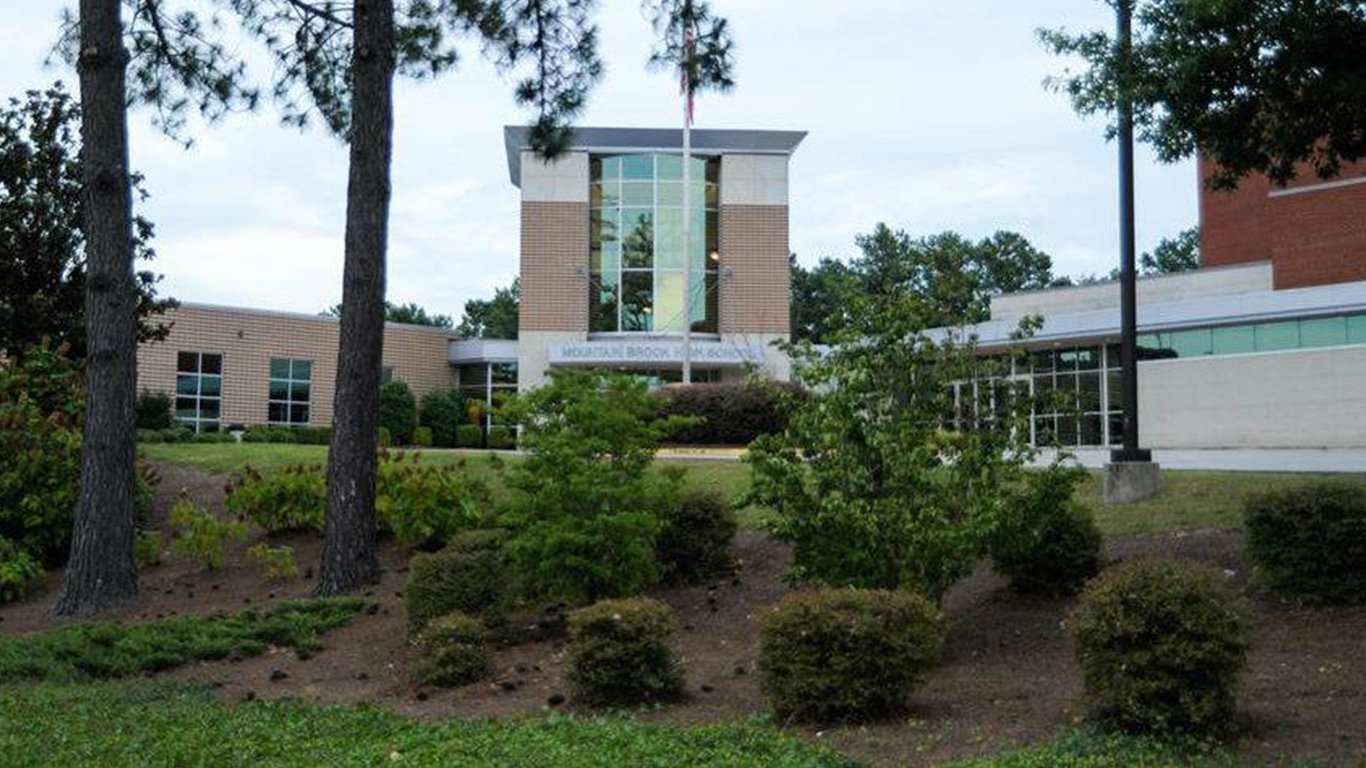
1. Alabama: Mountain Brook Schools
> Location: Jefferson County
> Annual per student spending: $13,303
> Adults with a bachelor’s degree: 85.1%
Alabama’s Mountain Brook School District, located just outside of Birmingham, educates over 4,000 students in grades K-12 in six different schools. While there is no direct link between school spending and outcomes, schools with greater financial resources can often offer students with a broader range of opportunities. Per pupil spending in the Mountain Brook district is over $13,000 per year, the most of any district in Alabama.
Children in the district are also less likely than most to be disadvantaged outside of the classroom. For example, the stresses associated with living in poverty can hurt academic performance, and in Mountain Brook, just 6.5% of school-age children live below the poverty line, well below the 17.0% U.S. child poverty rate.
[in-text-ad]
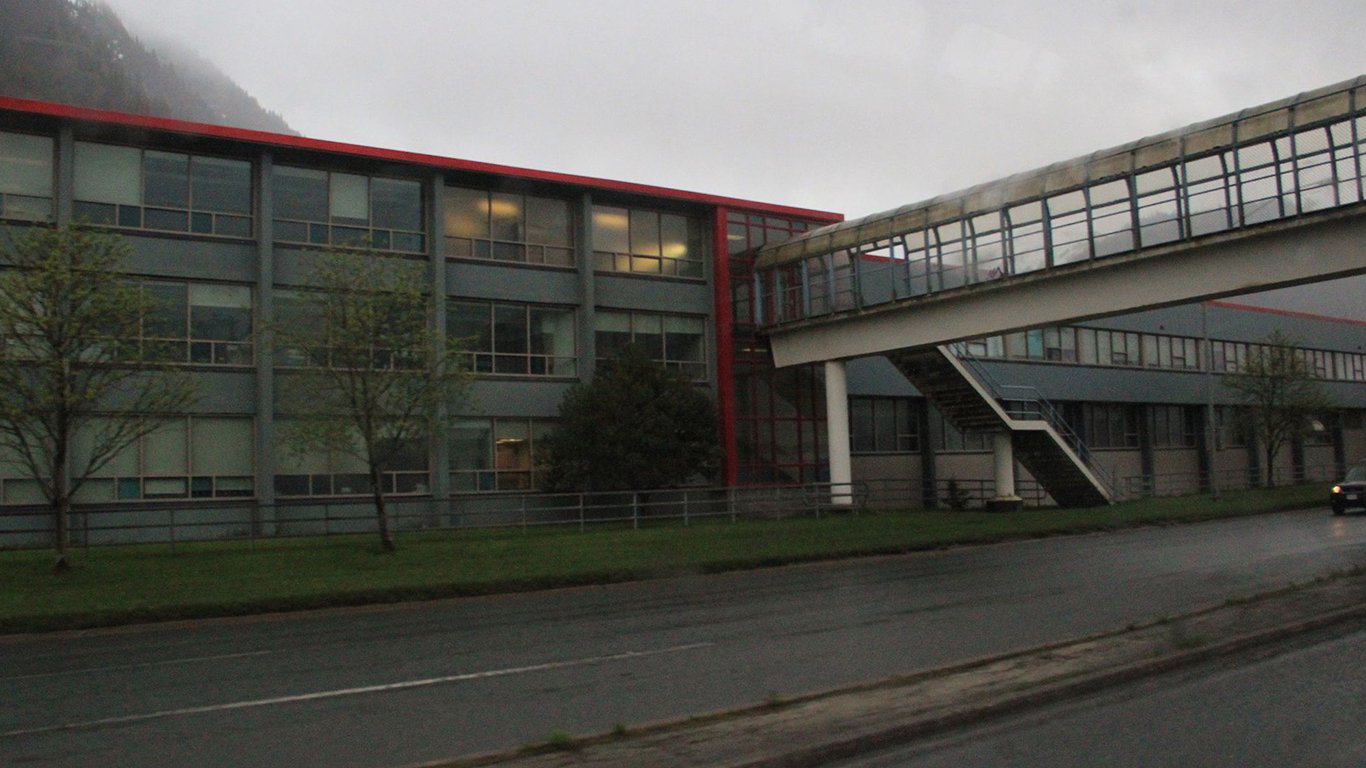
2. Alaska: Juneau School District
> Location: Juneau City and Borough
> Annual per student spending: $16,494
> Adults with a bachelor’s degree: 39.5%
A child’s academic performance tends to increase with parental educational attainment — and in the Juneau School District, parents are more likely to have a college education than parents nationwide. An estimated 39.5% of adults 25 and over in the district have a bachelor’s degree, well above the 31.5% national rate.
Students in the Juneau district are also more likely to be enrolled in Advanced Placement classes than those in any other district in the state. Of the nearly 5,000 students in the district, 7.9% are enrolled in an AP class.
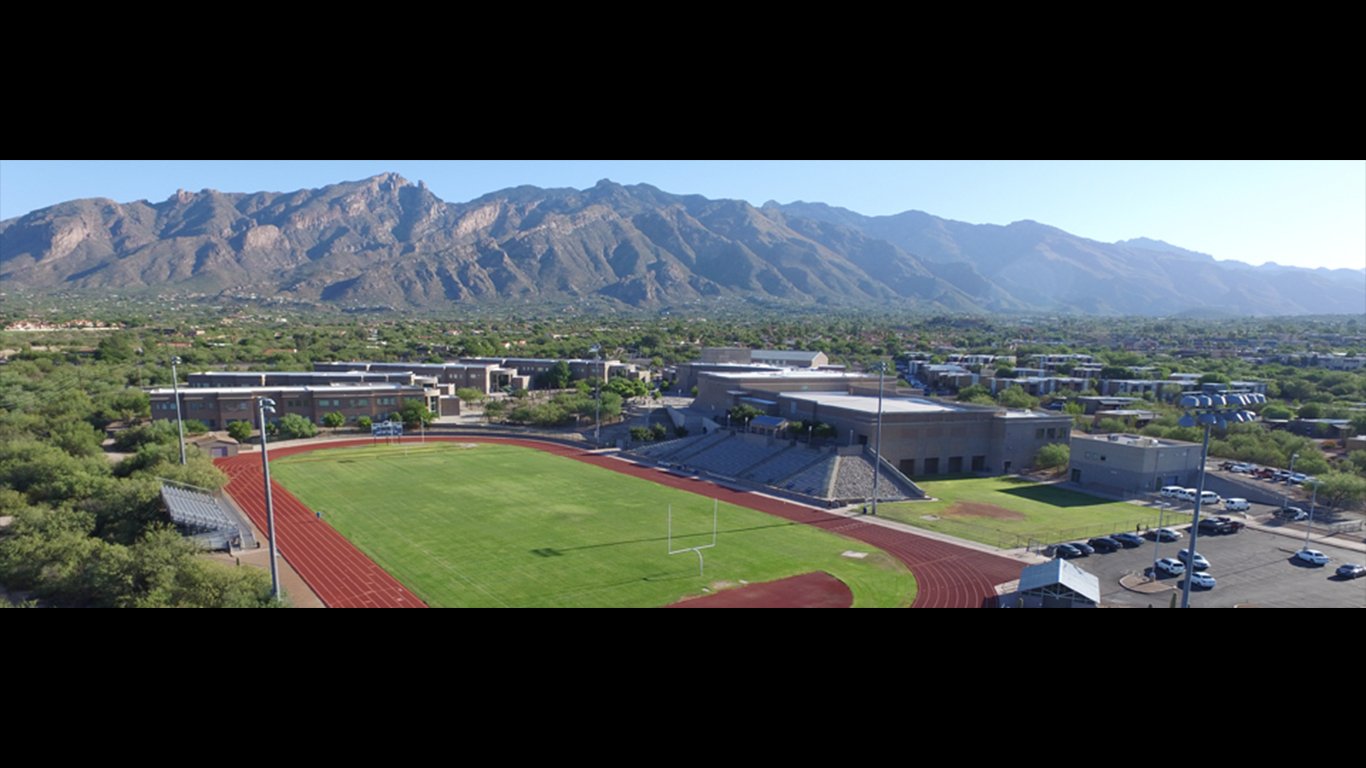
3. Arizona: Catalina Foothills School District 16
> Location: Pima County
> Annual per student spending: $7,070
> Adults with a bachelor’s degree: 70.1%
The Catalina Foothills School District 16, located in the northern part of the Tucson metropolitan area, ranks as the best district in Arizona. The district has one of the most affluent populations in the country, as well as one of the most highly educated — approximately 70% of adults have a bachelor’s degree. Students who grow up in an affluent household with college-educated parents are more likely to achieve academic success.
The school district’s per student spending per year is lower than many of the school districts on this list, at just over $7,000 per pupil.
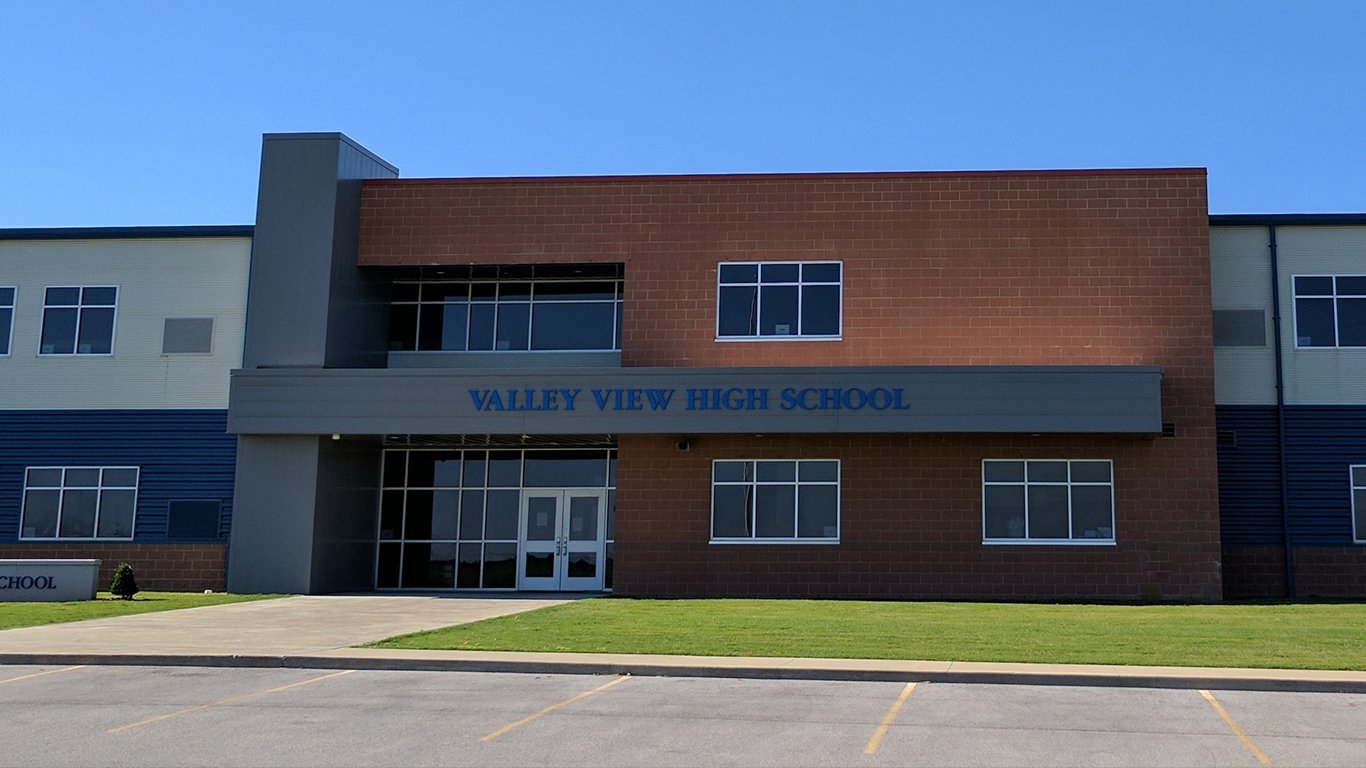
4. Arkansas: Valley View Schools
> Location: Craighead County
> Annual per student spending: $8,692
> Adults with a bachelor’s degree: 45.3%
Valley View School District, located in northeastern Arkansas, enrolls about 3,000 students across four schools. The district’s ranking on this list is due in large part to positive educational outcomes, as over 90% of high school freshman graduate in four years.
The greater likelihood of academic success in the district is partially due to factors outside the classroom. For example, children raised by college-educated parents are more likely than most to do well in school. Across Valley View District, 45.3% of adults have a bachelor’s degree or higher, well above the comparable 31.5% share of adults nationwide.
[in-text-ad-2]
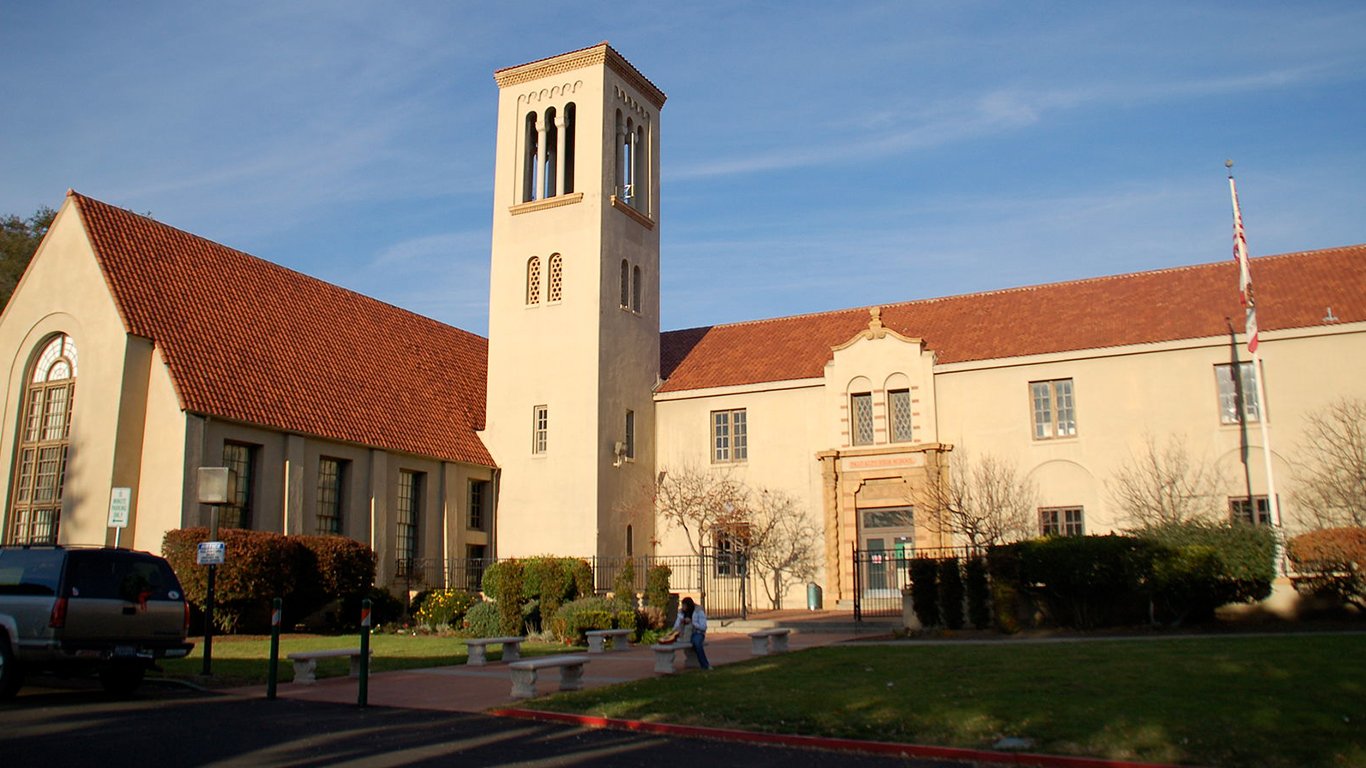
5. California: Palo Alto Unified School District
> Location: Santa Clara County
> Annual per student spending: $19,648
> Adults with a bachelor’s degree: 83.8%
Public school spending on a per student basis is nearly $20,000 per year in the Palo Alto School District. The high spending is due in part to high revenue from property taxes as Palo Alto is one of the wealthiest parts of the country with relatively expensive real estate.
While high per student spending does not necessarily translate to positive outcomes, the district boasts a near perfect graduation rate. Additionally, over 95% of students who take one or more AP exams pass at least one.
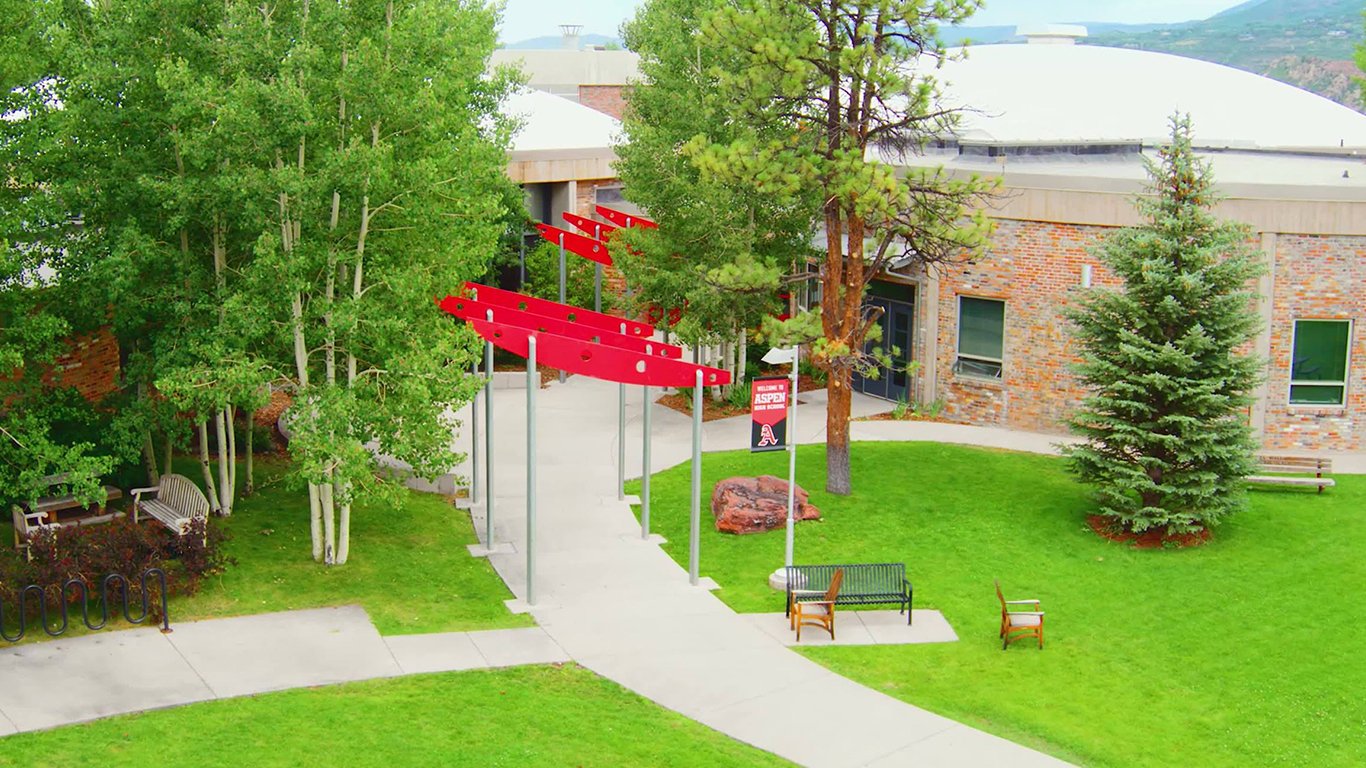
6. Colorado: Aspen School District
> Location: Pitkin County
> Annual per student spending: $16,820
> Adults with a bachelor’s degree: 69.4%
As a highly affluent school district, Colorado’s Aspen School District 1 relies relatively little on state or federal revenue to fund its schools. In 2017, 83.8% of the district revenue came from local sources, close to double the average among districts nationwide of 45.8%.
Living in poverty can be a major obstacle for childhood development, and in the district, just 3.4% of children 5 to 17 live in poverty, a lower child poverty rate than the vast majority of school districts nationwide and well below the national child poverty rate of 17.0%.
[in-text-ad]

7. Connecticut: Darien Public School District
> Location: Fairfield County
> Annual per student spending: $21,648
> Adults with a bachelor’s degree: 81.3%
Darien is one of the wealthiest school districts in the country, with a median annual household income of over $210,000. Likely partially as a result, per-pupil spending in the district of $21,648 exceeds the national per pupil spending average of $12,201.
The district ranks sixth out of 130 districts in the state in Niche’s ranking of teacher quality. Darien High School, the only high school in the district, has an average SAT score of 1310 and an average ACT score of 30, well above average scores for high school students nationwide.
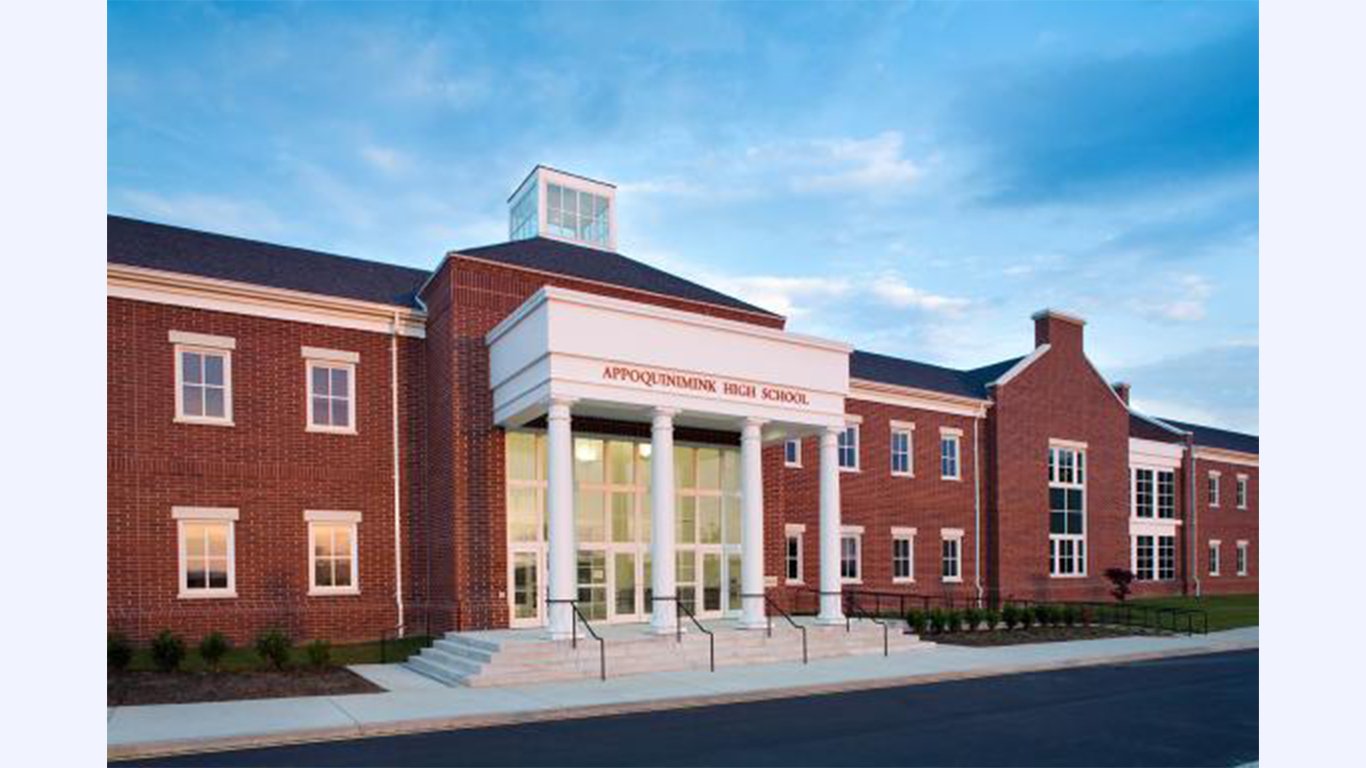
8. Delaware: Appoquinimink School District
> Location: New Castle County
> Annual per student spending: $12,567
> Adults with a bachelor’s degree: 37.2%
Delaware’s Appoquinimink School District — which is located in the northern part of the state, approximately 20 miles south of Wilmington — ranks as the best in the state. The district’s per student spending of $12,567 is in the middle of most of the districts on this list, although still slightly higher than the national per pupil spending figure of $12,201.
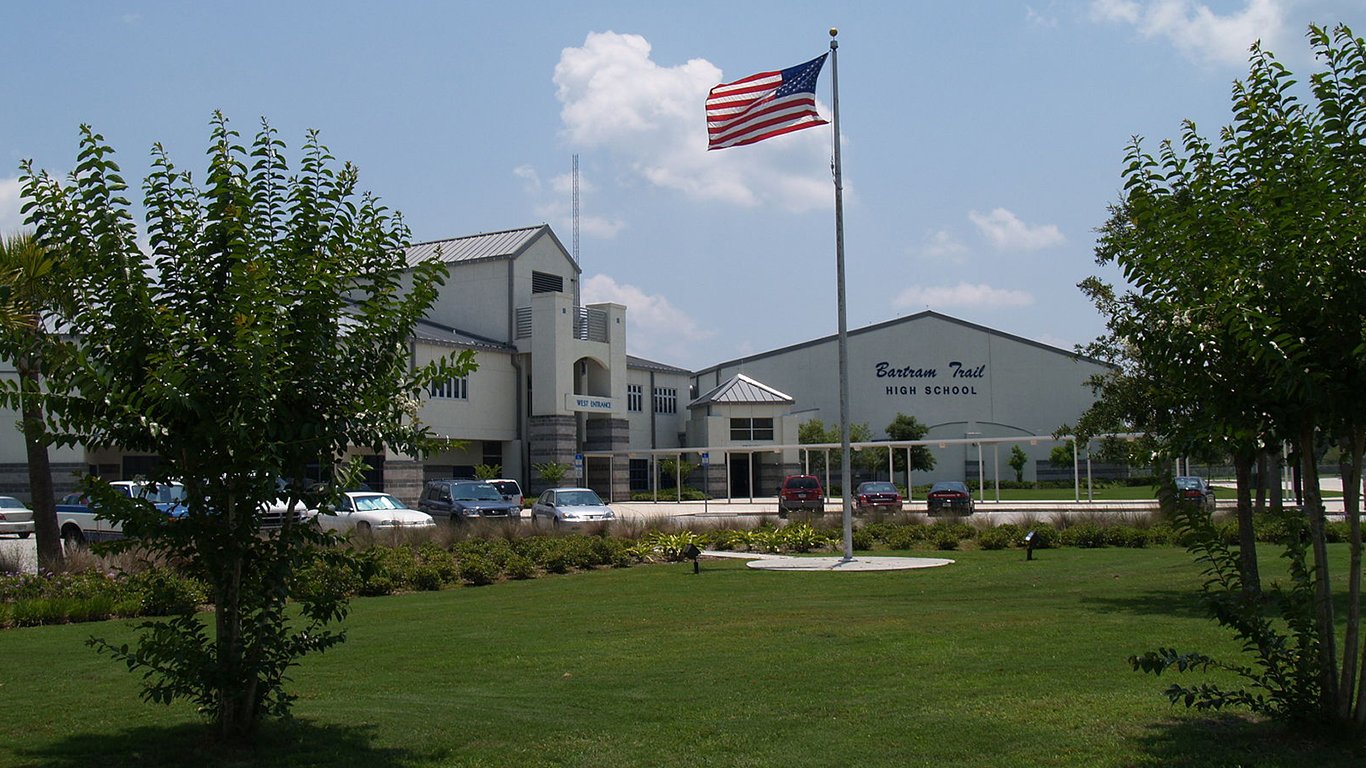
9. Florida: St. Johns County School District
> Location: St. Johns County
> Annual per student spending: $8,331
> Adults with a bachelor’s degree: 43.7%
The St. Johns County School District is located along Florida’s Atlantic coast and covers the city of St. Augustine. The school district’s 88.6% graduation rate is the highest in the state and well above the 70.8% average graduation rate across all Florida school districts.
Children who grow up in financially stable households with college-educated parents are at a considerable advantage academically. In the St. Johns County School District, 43.7% of adults have a bachelor’s degree, and just 6.5% of children live below the poverty line — compared to the 29.2% and 18.4% respective state averages.
[in-text-ad-2]
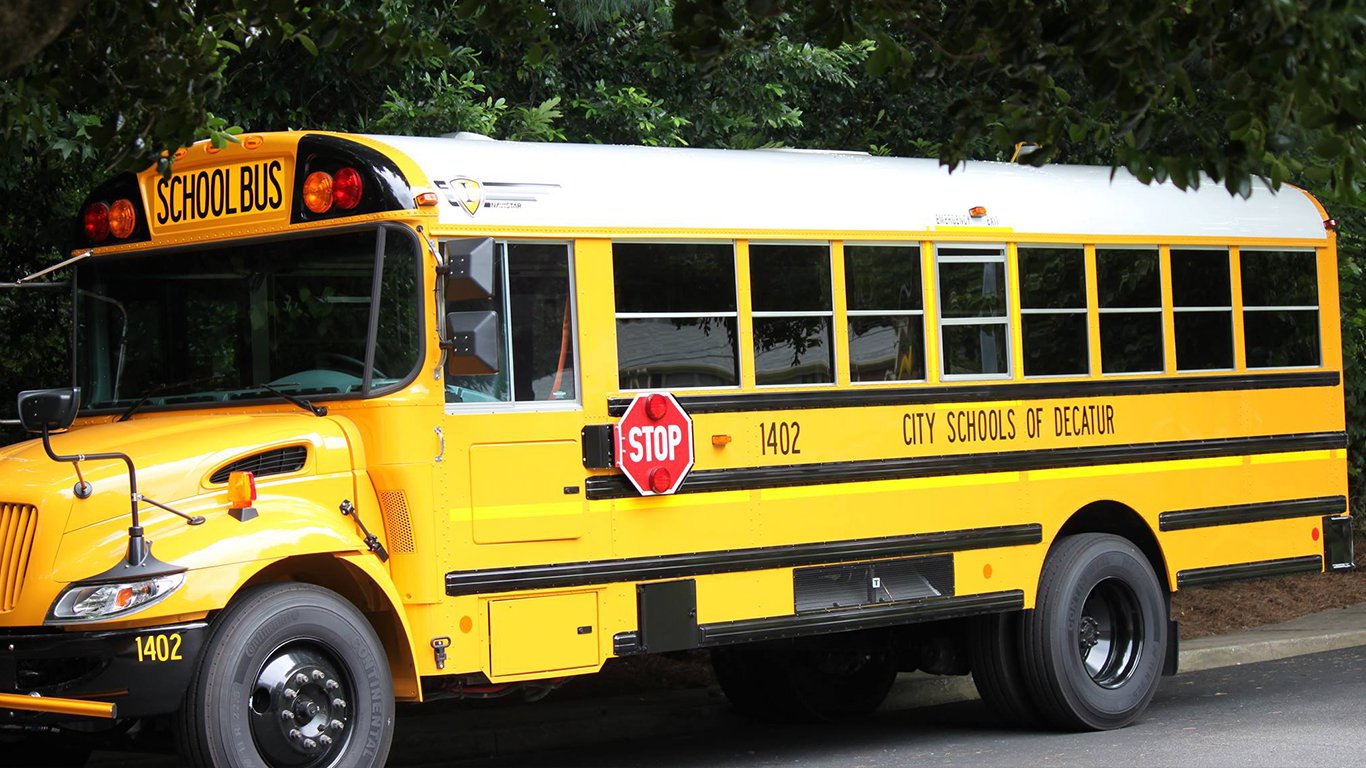
10. Georgia: City Schools of Decatur
> Location: DeKalb County
> Annual per student spending: $11,657
> Adults with a bachelor’s degree: 72.5%
Georgia’s Decatur school district spends $11,657 per student per year, well above the $10,205 statewide average. The greater school spending likely contributes to the smaller class sizes, as the district has about one teacher per 14.2 students — well below the one teacher per 15.2 students ratio across Georgia.
Students in the Decatur District are far more likely to graduate high school than the typical student in Georgia. About 85.5% of high school students in Decatur graduate within four years, a far larger share than the 69.9% state average.

11. Hawaii: Hawaii Public Schools
> Location: Honolulu County
> Annual per student spending: $14,322
> Adults with a bachelor’s degree: 32.5%
Hawaii is the only state to have a single school district manage every public school. Therefore, the district’s ranking on this list is by default only. Still, by several measures, public school students in Hawaii have some advantages over students nationwide. For example, per student spending in the state is $14,322 compared to the national average of $12,201. Higher-spending districts often have smaller class sizes, and in Hawaii, the average student-teacher ratio of 15 to 1 is slightly lower than the 16.1 to 1 national average.
[in-text-ad]
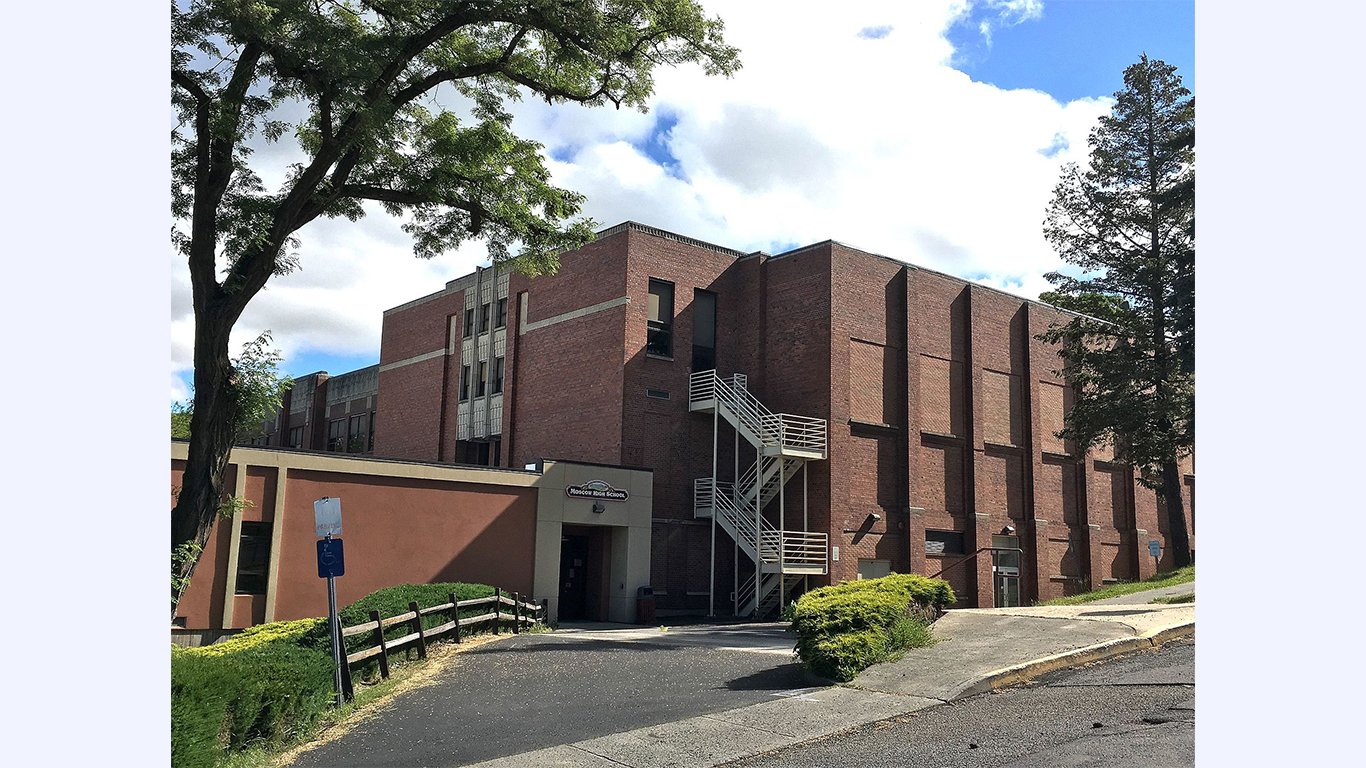
12. Idaho: Moscow School District 281
> Location: Latah County
> Annual per student spending: $9,970
> Adults with a bachelor’s degree: 55.3%
Idaho’s Moscow School District 281 enrolls about 2,400 students in part of the northwestern section of the state. High school students in the district are more likely to be enrolled in an AP course than the typical high schooler in Idaho. Some 24.0% of high schoolers are taking an AP class compared to 17.4% of high school students across the state.
Children of college-educated parents are more likely to be academically successful than children of parents who never went to college. Across the Moscow School District, 55.3% of adults have a bachelor’s degree, well above the 26.9% share of adults across the state as a whole.
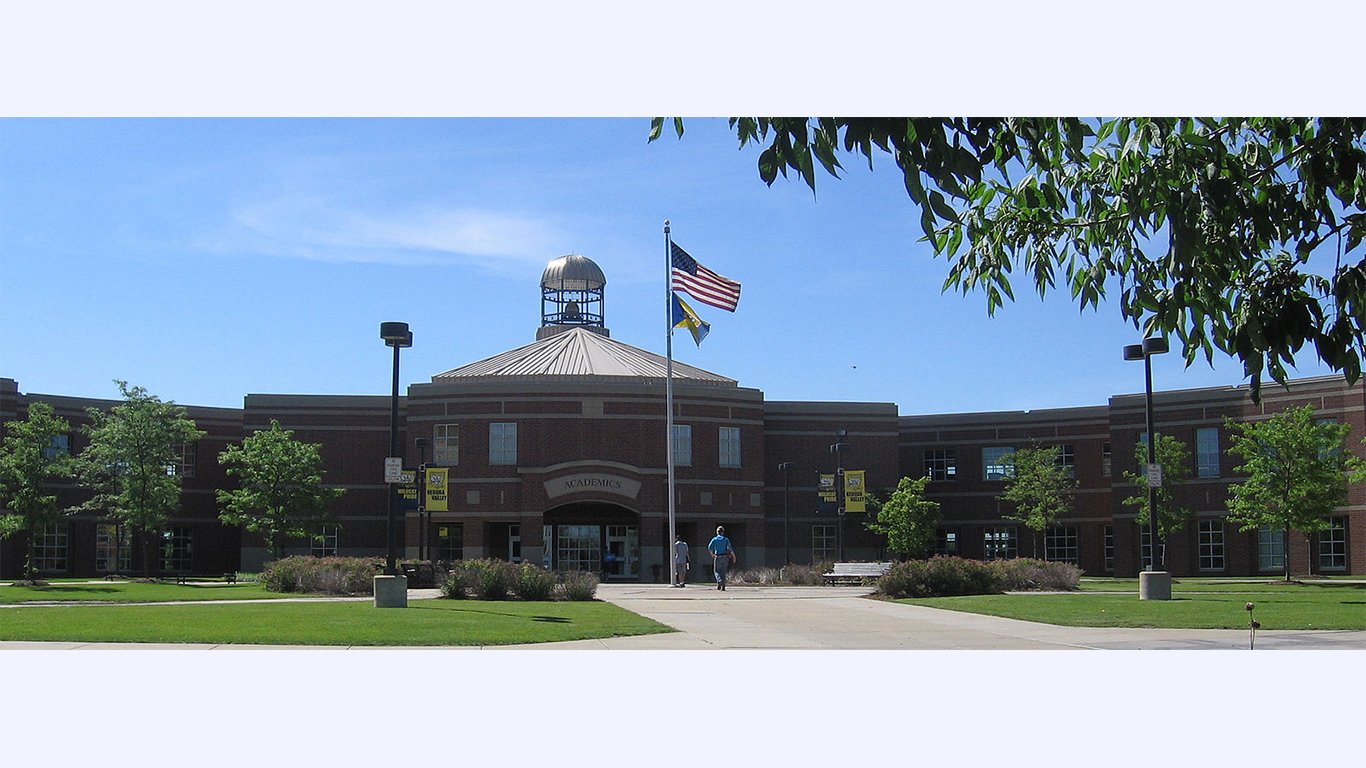
13. Illinois: Indian Prairie School District 204
> Location: DuPage County
> Annual per student spending: $15,738
> Adults with a bachelor’s degree: 63.4%
Compared to most of the districts on this list, Indian Prairie Community Unit School District in Illinois is relatively large, with over 28,000 students and 33 operational schools in total. The district serves wealthy Chicago suburbs such as Naperville.
Student achievement is quite high in the large district, with Niche reporting an average SAT score across district students of 1300 and an average ACT score of 29, both well above the national averages. An estimated 37.1% of high school students in the district take at least one AP course, well above the 21.5% of high school students nationwide. Teachers are also well compensated, with the average teacher earning over $70,000.
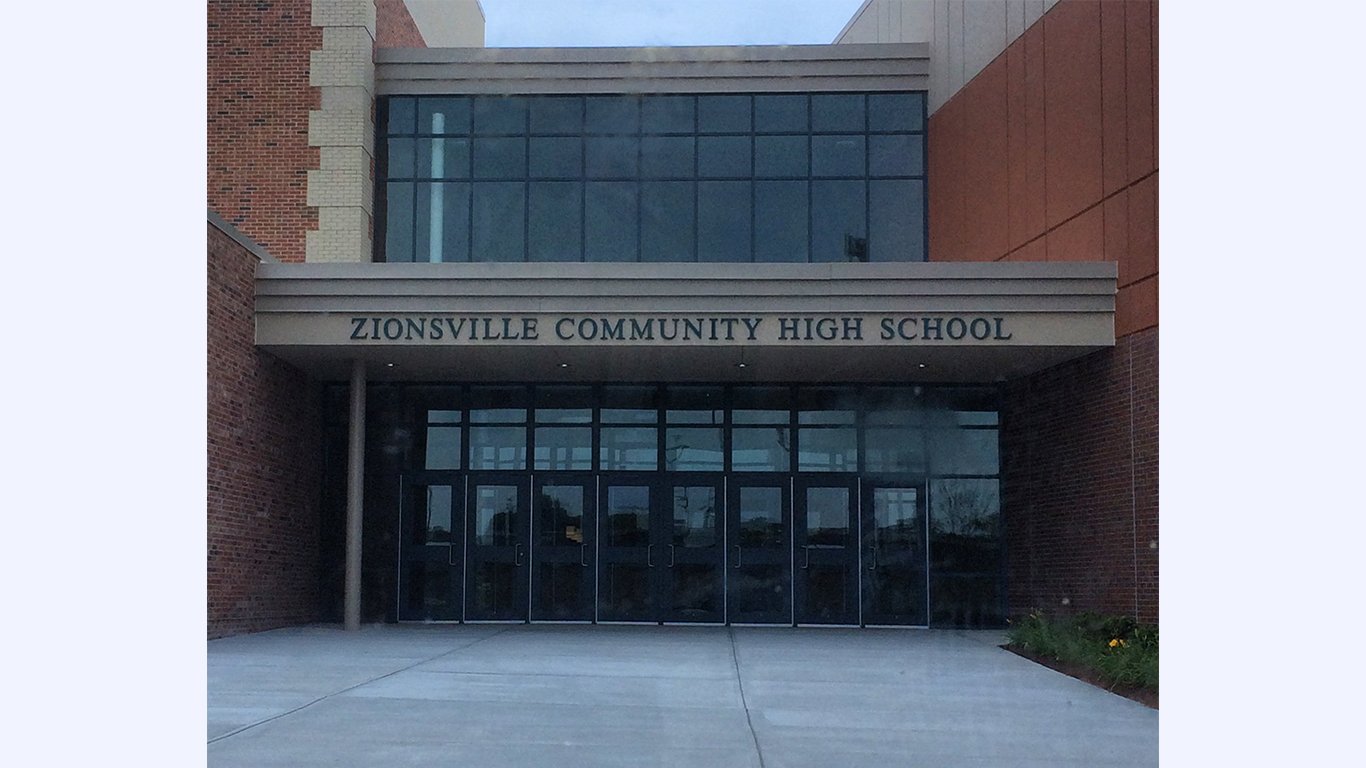
14. Indiana: Zionsville Community Schools
> Location: Boone County
> Annual per student spending: $9,073
> Adults with a bachelor’s degree: 70.6%
Children of parents with a college education are more likely to have higher academic achievement than the typical student. In Indiana’s Zionsville school district, located just north of Indianapolis, 70.6% of adults have a bachelor’s degree or higher, well above the 25.9% of adults across the state as a whole. Zionsville also boasts a near perfect high school graduation rate.
[in-text-ad-2]
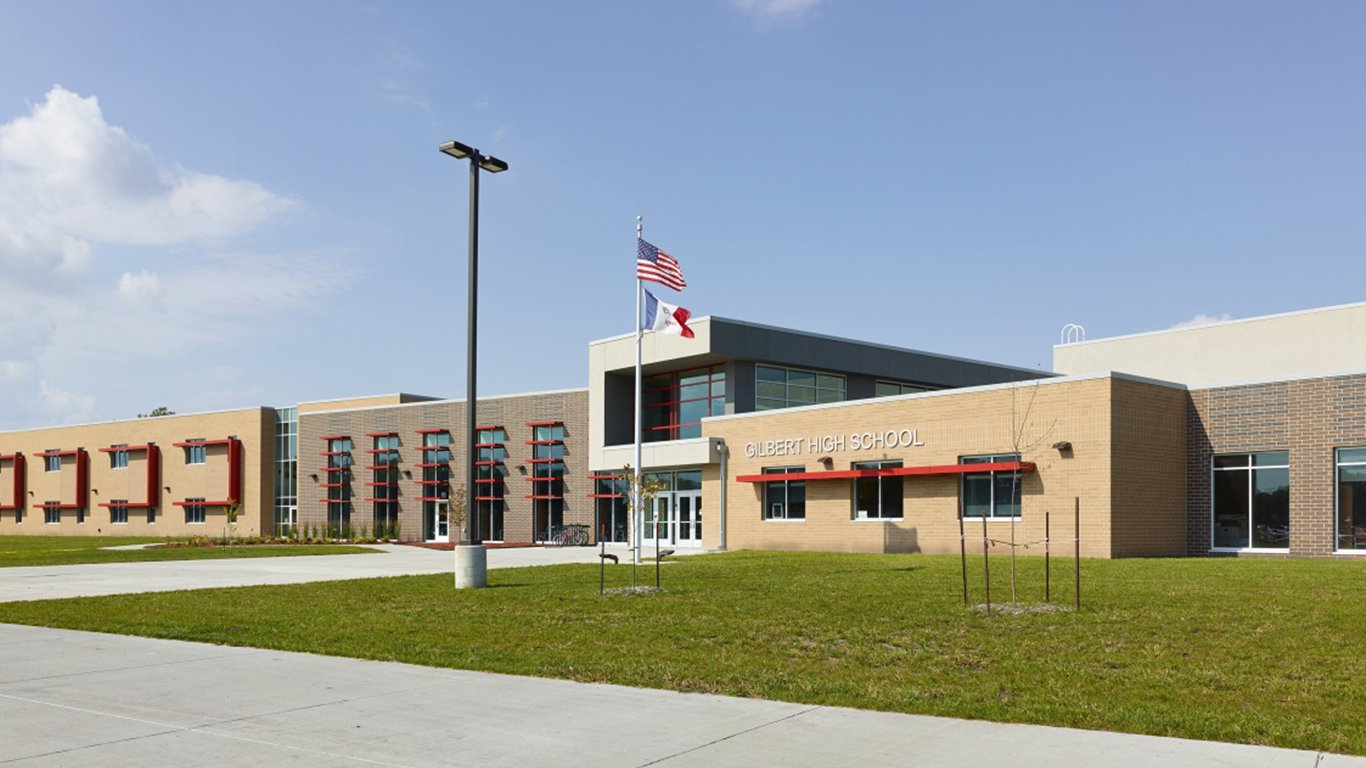
15. Iowa: Gilbert Community School District
> Location: Story County
> Annual per student spending: $9,733
> Adults with a bachelor’s degree: 63.5%
While per pupil spending isn’t as high as many of the other districts in the district, Iowa’s Gilbert Community School District, north of the city of Ames, has some of the best student outcomes in the country.
Like a number of the best school districts in each state, Gilbert Community School District has a near-perfect graduation rate. Additionally, according to Niche, 95% of students in the district test as proficient in reading, and 97% test as proficient in math. The average SAT scores among students in the district is 1420, far higher than the national average SAT scores.

16. Kansas: Blue Valley Schools
> Location: Johnson County
> Annual per student spending: $9,850
> Adults with a bachelor’s degree: 70.2%
The Blue Valley Unified School District has one of the highest graduation rates of any school district with at least 500 students. Nearly all ninth graders in the district — over 96% — graduate high school in four years, well above the 84.5% statewide graduation rate.
Children of college-educated parents are more likely to be academically successful than children of parents who never went to college. Across the district, 70.2% of adults have a bachelor’s degree, well above the 32.9% share of adults across the state as a whole.
[in-text-ad]
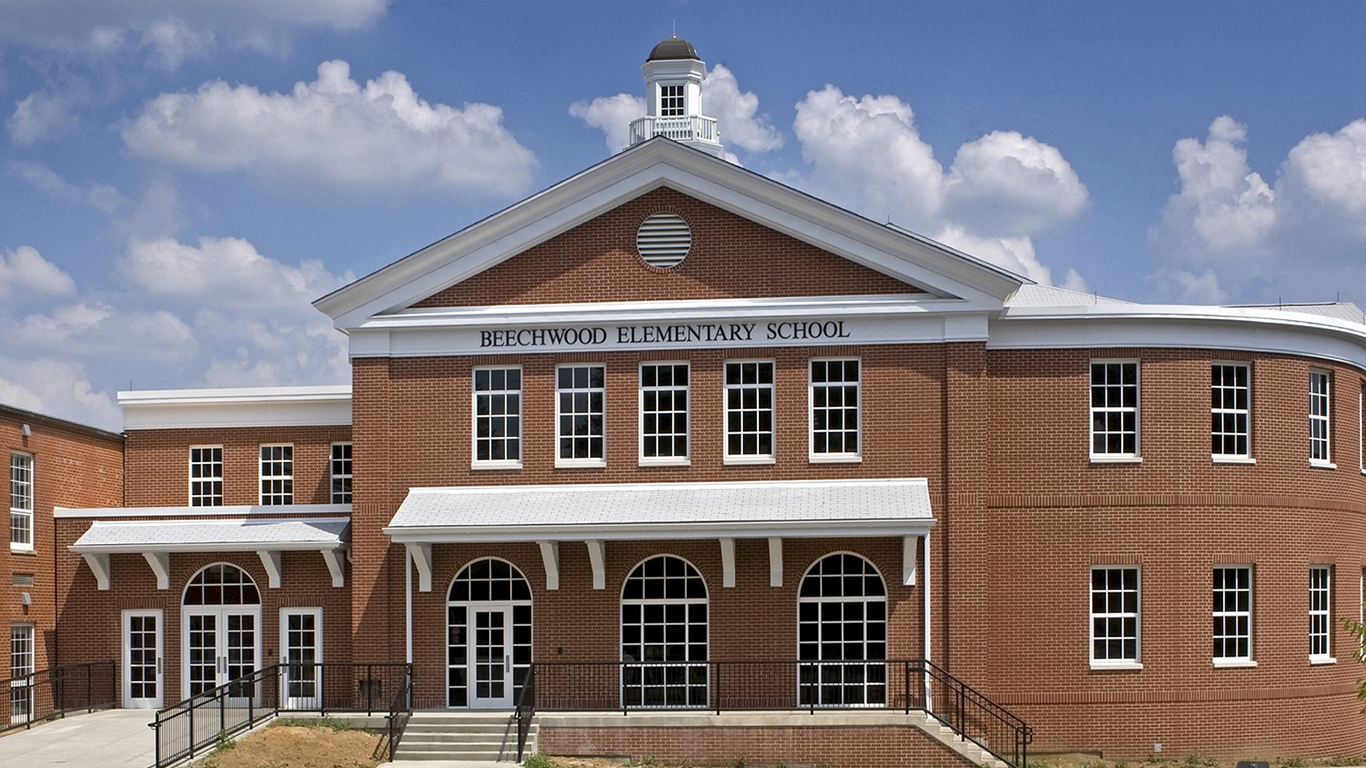
17. Kentucky: Beechwood Independent Schools
> Location: Kenton County
> Annual per student spending: $8,964
> Adults with a bachelor’s degree: 57.3%
Children growing up in poverty face unique hardships and stressors that can have a negative impact on academic performance. However, such conditions are rare in Kentucky’s Beechwood Independent School District. Just 4.1% of area children live below the poverty line, a fraction of the 20.5% statewide child poverty rate.
With most students not saddled with financial hardship, certain academic outcomes are indeed better than average in the school district. For example, the district’s high school graduation rate is over 93%.
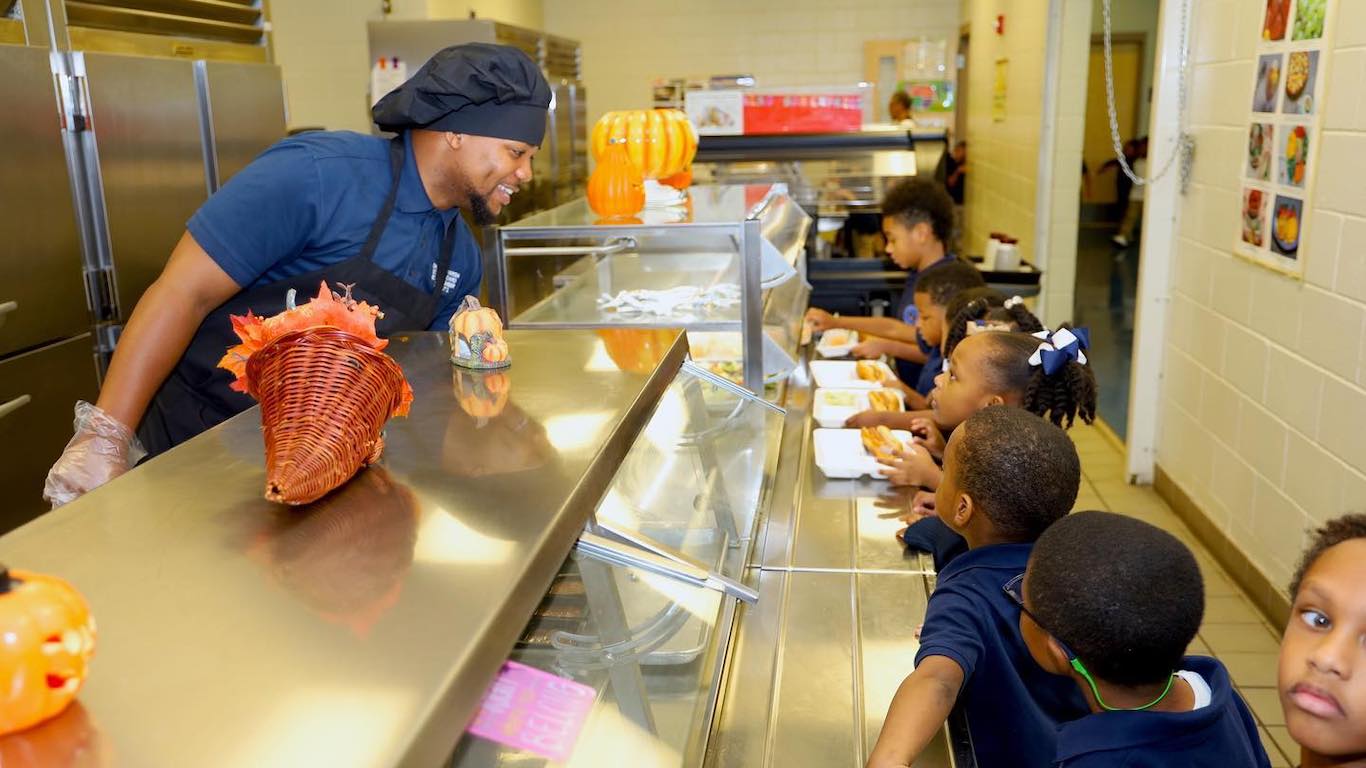
18. Louisiana: Orleans Parish Schools
> Location: Orleans Parish
> Annual per student spending: $12,761
> Adults with a bachelor’s degree: 36.8%
The Orleans Parish School District in Louisiana, which covers much of the greater New Orleans area, ranks as the district where students are most likely to succeed in the state. Public school spending per student in the district is $12,761, above the $11,199 average spending across the state as a whole.
While higher spending does not necessarily translate to better outcomes, the higher spending likely contributes to smaller class sizes in Orleans Parish. The district’s student-to-teacher ratio of 16.9 to 1 is well below the 17.8 to 1 state ratio.
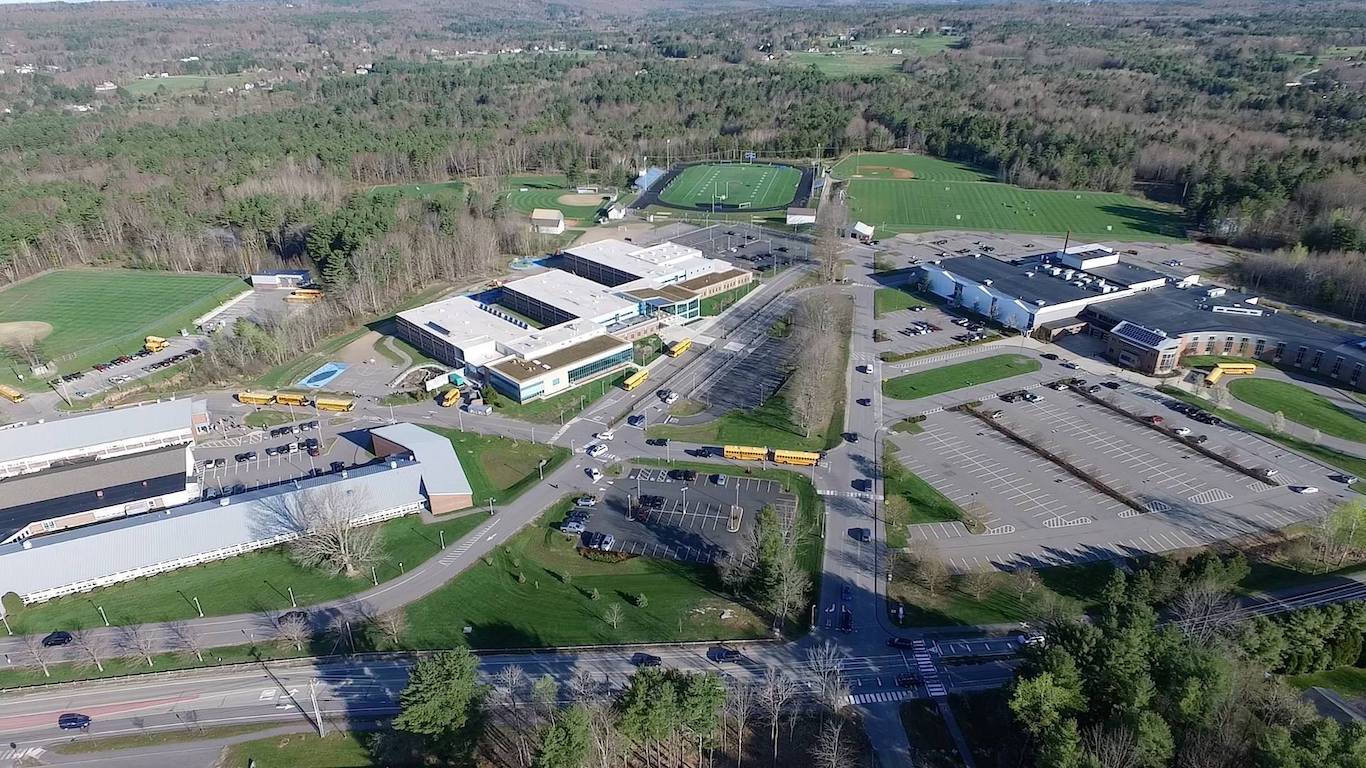
19. Maine: Falmouth School Department
> Location: Cumberland County
> Annual per student spending: $15,663
> Adults with a bachelor’s degree: 69.0%
Smaller class sizes have been linked to better outcomes. In Maine’s Falmouth School District, located in Cumberland County just outside of Portland, there are 11.5 students per teacher, below the 12.2 to 1 state average ratio and the 16.1 to 1 national average ratio.
Students enrolled in the district are also more likely than those in most other Maine public school districts to graduate high school. More than 90% of high school ninth graders in Falmouth graduate in four years.
[in-text-ad-2]
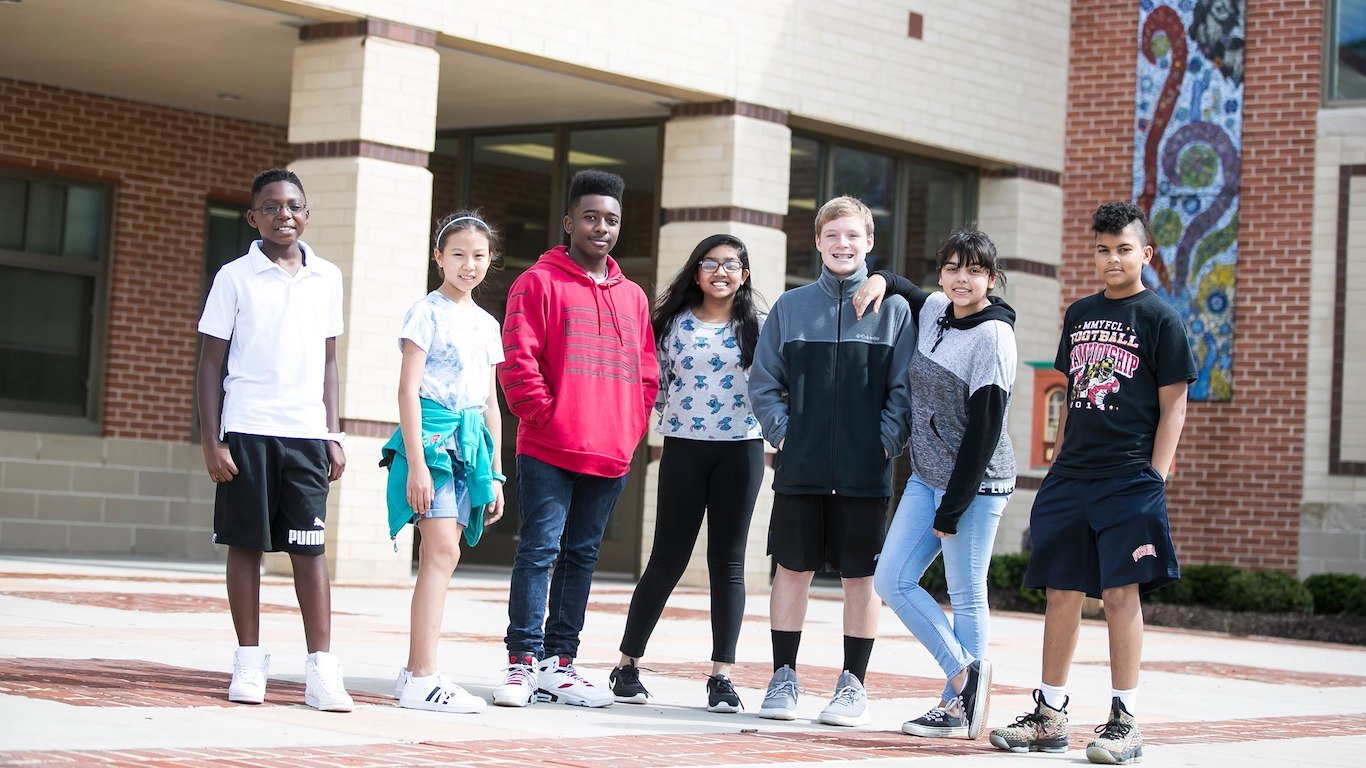
20. Maryland: Howard County Public School System
> Location: Howard County
> Annual per student spending: $15,921
> Adults with a bachelor’s degree: 61.4%
Maryland’s Howard County School district, located just outside of Baltimore, ranks as the best in the state due in large part to conditions outside of the classroom. For example, while the stressors associated with serious financial hardship can detract considerably from academic performance, just 5.7% of children in the district live below the poverty line, compared to 11.4% of children statewide. Additionally, children of college-educated parents are more likely to be academically successful than children of parents who never went to college. Across the district, 61.4% of adults have a bachelor’s degree, the largest share of any school district in Maryland.

21. Massachusetts: Public Schools of Brookline
> Location: Norfolk County
> Annual per student spending: $20,250
> Adults with a bachelor’s degree: 83.7%
Per pupil spending is not a guarantee of good student outcomes, but higher spending can come with certain advantages. And at Massachusetts’ Brookline public school system, per pupil spending exceeds $20,000 annually, roughly $8,000 greater than national per pupil spending.
As is usually the case in high-spending districts, Brookline — a suburb of Boston — is a relatively affluent community, with a median household income of $113,515. Students who grow up in an affluent household with college-educated parents have a greater chance to succeed academically. Among the district’s adults, 83.7% have at least a bachelor’s degree, one of the 10 highest shares of any school district in the United States.
[in-text-ad]
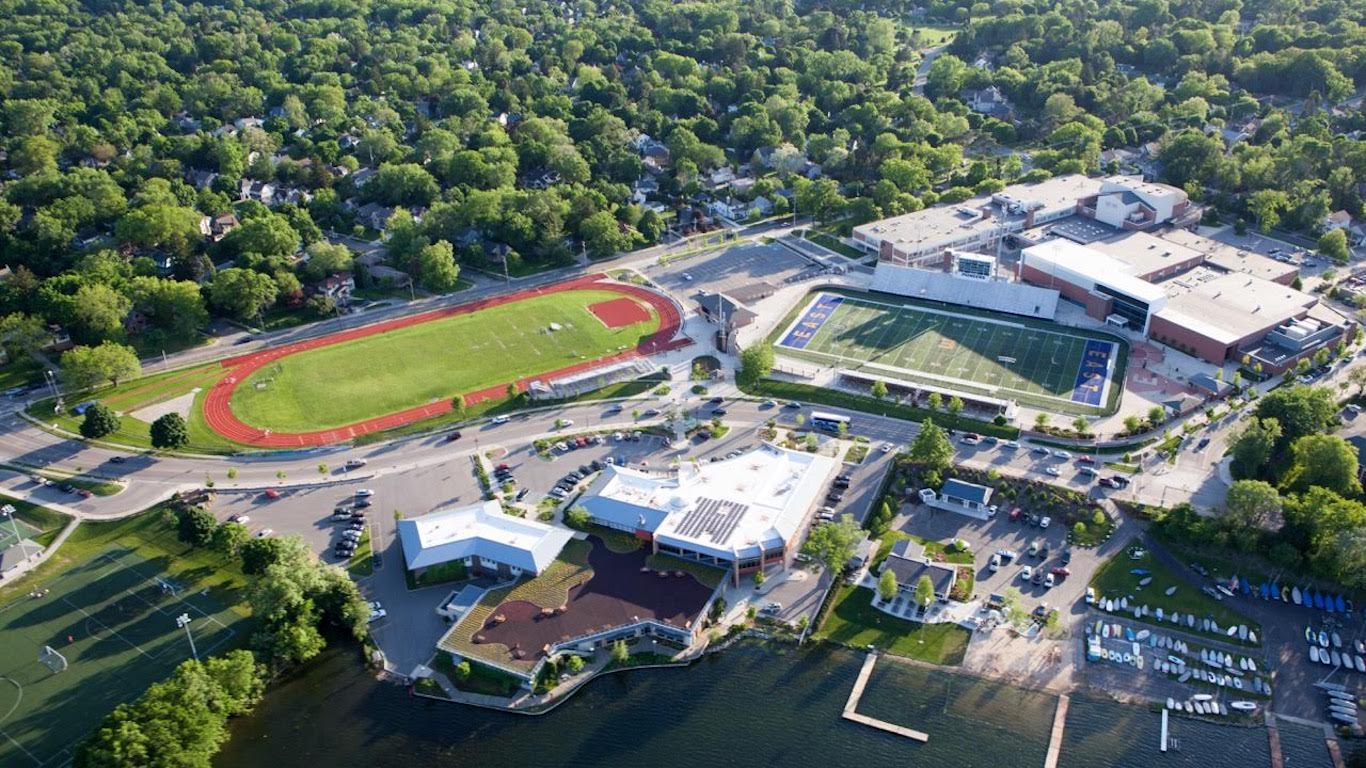
22. Michigan: East Grand Rapids Public Schools
> Location: Kent County
> Annual per student spending: $9,975
> Adults with a bachelor’s degree: 78.4%
While the East Grand Rapids Public School District has lower than average per pupil spending and a higher than average student-to-teacher ratio, conditions outside the classroom give children in the area an academic advantage. For one, 78.4% of adults in the school district have a bachelor’s degree, well above the 28.6% share of adults across Michigan as a whole — and children of college-educated parents are more likely than average to be successful academically. Indeed, the district has a high school graduation rate over 95%.

23. Minnesota: Edina Public Schools
> Location: Hennepin County
> Annual per student spending: $11,815
> Adults with a bachelor’s degree: 72.7%
Minnesota’s Edina Public Schools, just southwest of Minneapolis, comprises 12 schools that enroll nearly 9,000 students. The best district in the state, Edina’s high school graduation rate is over 92%. Students in the district are also more likely to be enrolled in advanced, college level courses than students in districts statewide. An estimated 25.3% of high schoolers in Edina are enrolled in an AP class, compared to 21.5% of students nationwide.

24. Mississippi: Madison County School District
> Location: Madison County
> Annual per student spending: $9,117
> Adults with a bachelor’s degree: 54.1%
Students in the Madison County School District benefit from smaller than average class sizes. The student-to-teacher ratio in Mississippi’s best school district is 14.5 to 1, below both the 15.1 to 1 average ratio statewide and 16.1 to 1 ratio nationwide. Additionally, the district’s 84% high school graduation rate is better than most other districts in the state.
[in-text-ad-2]
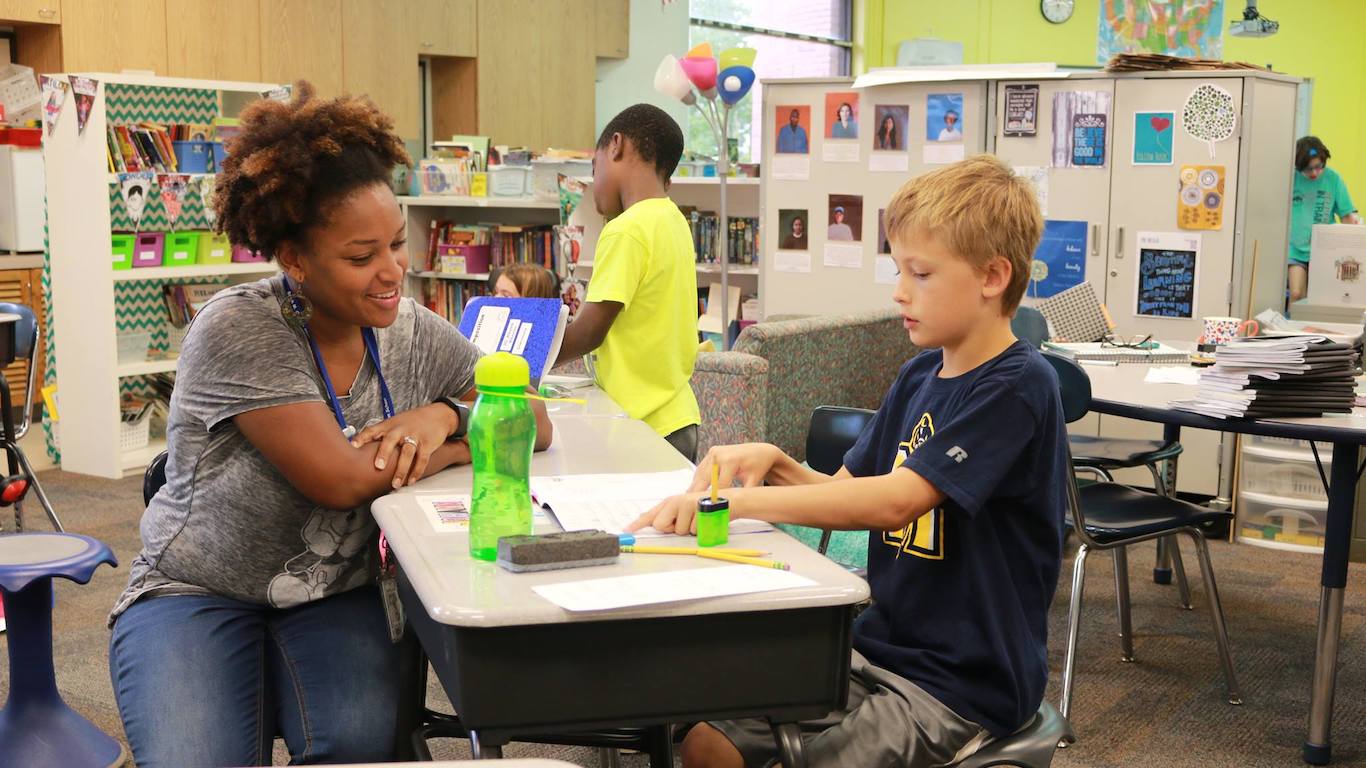
25. Missouri: School District of Clayton
> Location: St. Louis County
> Annual per student spending: $21,268
> Adults with a bachelor’s degree: 77.4%
While high per pupil spending is no guarantee of better outcomes, it can provide students with greater opportunities and advantages. In Missouri’s School District of Clayton, per pupil spending is $21,268 per year, roughly double the average of $10,589 across the state as a whole. In districts that spend more, students often benefit from smaller class sizes. In Clayton, there are 11.8 students per teacher, below the 13.4 to 1 student-to-teacher ratio statewide.

26. Montana: Frenchtown School District
> Location: Missoula County
> Annual per student spending: $9,670
> Adults with a bachelor’s degree: 31.3%
Montana’s Frenchtown School District is relatively small, with roughly 1,300 students in total. Children who grow up in poverty face a number of disadvantages that make it more difficult to succeed academically, but the Frenchtown district has a relatively low child poverty rate. An estimated 7.3% of district children 5 to 17 live in poverty, compared to a state share of 14.3% and a national child poverty rate of 17.0%.
[in-text-ad]
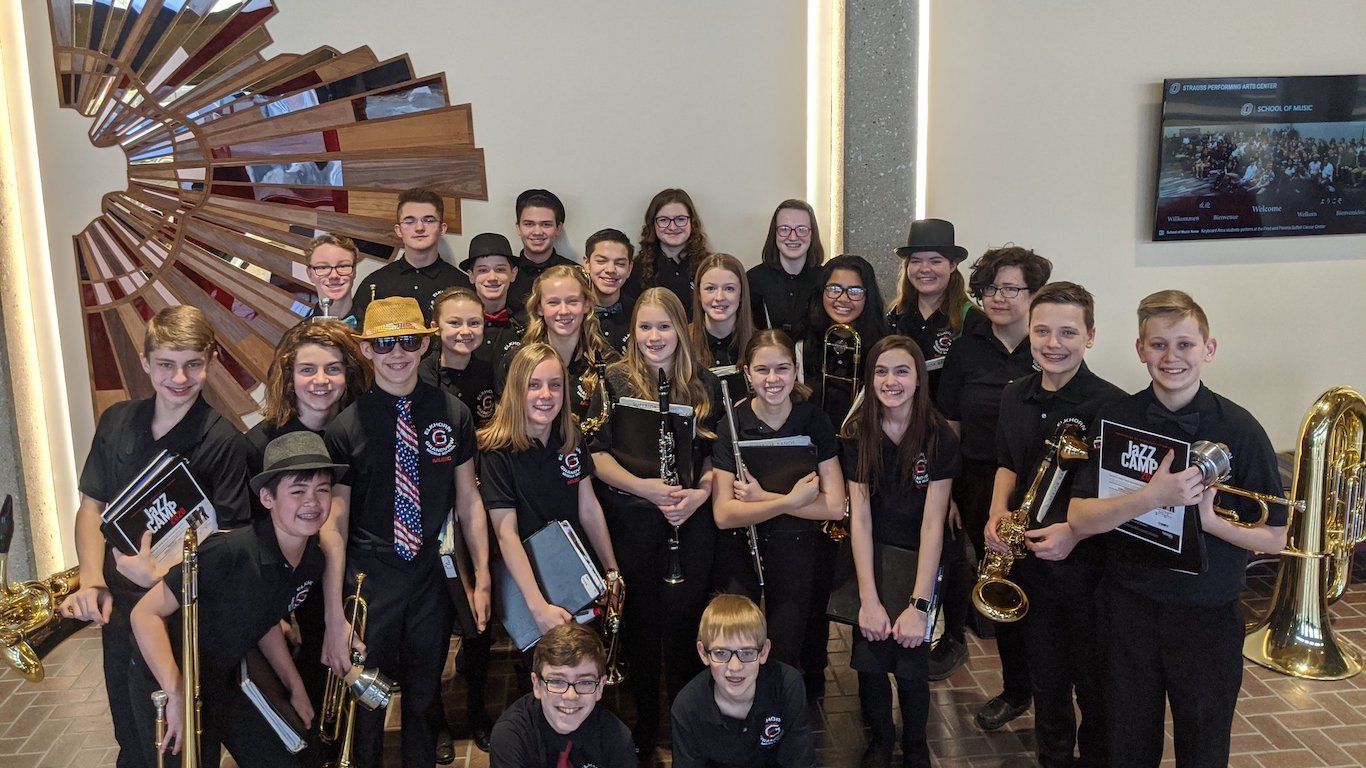
27. Nebraska: Elkhorn Public Schools
> Location: Douglas County
> Annual per student spending: $9,627
> Adults with a bachelor’s degree: 59.3%
Nebraska’s Elkhorn School District has one of the very lowest child poverty rates in the country, at just 2.0% of children 5 to 17, compared to a state child poverty rate of 11.2% and a national rate of 17.0%. Elkhorn is also one of a relative few districts in the country to boast a near perfect high school graduation rate. It also ranks as one of the best districts in other measures of student success, including an average SAT score of 1300 and an average ACT score of 28. Niche ranks the district as No. 1 in the state for overall district quality, safety, and teacher quality.

28. Nevada: Lander County School District
> Location: Lander County
> Annual per student spending: $12,897
> Adults with a bachelor’s degree: 11.6%
The Lander County School District, located in north-central Nevada, has one of the highest graduation rates in the state. Over 90% of all high school ninth graders in the district graduate within four years..
While higher spending does not necessarily lead to better outcomes, it can bring certain advantages. Spending on a per pupil basis is high in the Lander County School District is $12,897. Across all Nevada school districts, the average per pupil spending is just $9,320.

29. New Hampshire: Oyster River Cooperative School District
> Location: Strafford County
> Annual per student spending: $19,312
> Adults with a bachelor’s degree: 66.8%
In New Hampshire’s Oyster River Cooperative School District, annual per pupil spending is over $19,000, on average. This is about $3,600 higher than the average state per pupil spending figure and over $7,000 higher than the national average.
Students in the district are likely to live in homes that would contribute to their chances of success. The district has one of the lowest child poverty rates in the country, and about two-thirds of district adults have a college education, more than double the national college attainment rate and one of the highest in the country.
[in-text-ad-2]

30. New Jersey: Mountain Lakes School District
> Location: Morris County
> Annual per student spending: $26,861
> Adults with a bachelor’s degree: 86.8%
In New Jersey’s Mountain Lakes Borough School District, 86.8% of adults have at least a bachelor’s degree, the second highest share in of more than 10,000 districts. The district is also extremely affluent, with 54.3% of households in the district having an income of $200,000 or more, compared to 13.0% of the state’s households.
Niche ranks Mountain Lakes as both the best district to teach and the one with the best teachers in the state. The district has a student to teacher ratio of 9.5 to 1, well below the nationwide 16.1 to 1 average ratio.
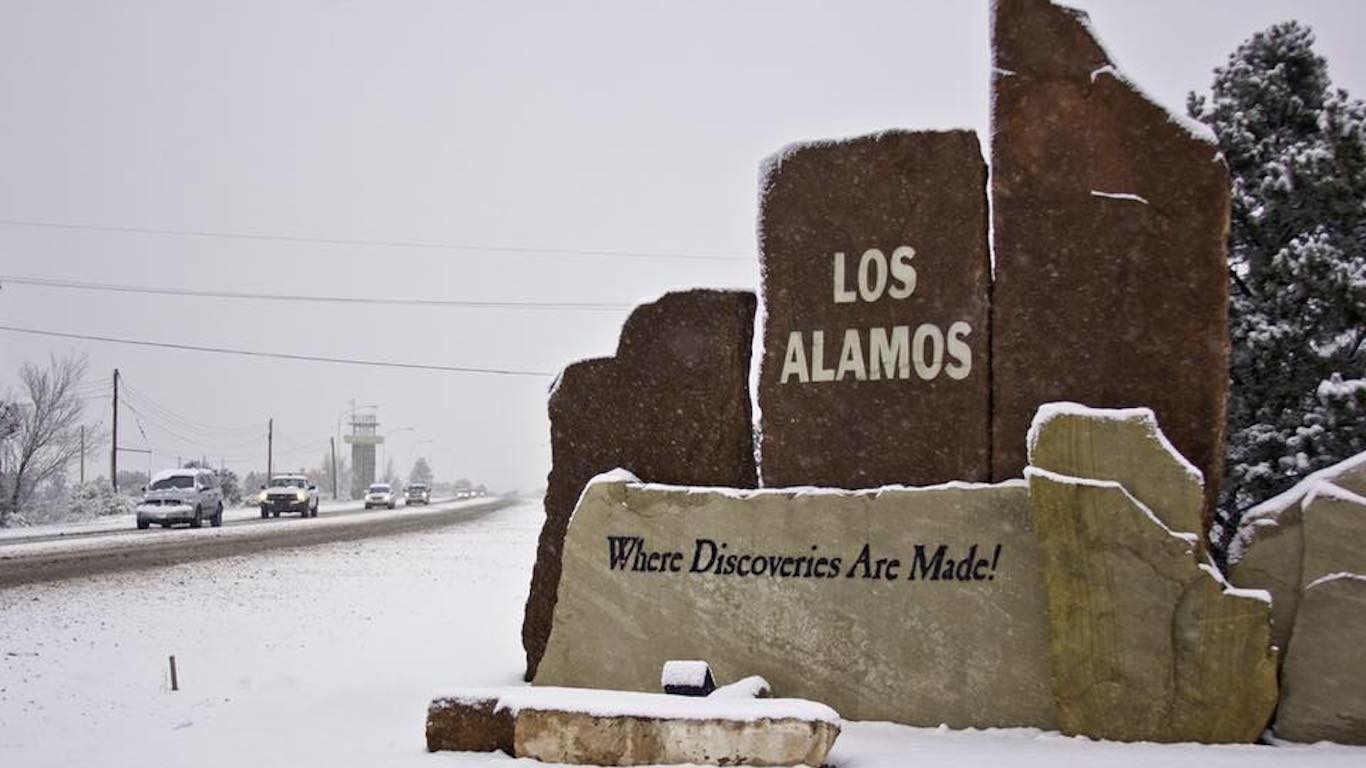
31. New Mexico: Los Alamos Public Schools
> Location: Los Alamos County
> Annual per student spending: $10,804
> Adults with a bachelor’s degree: 66.5%
Children of college-educated parents are more likely to be academically successful than children of parents who never went to college. Across the Los Alamos School District, 66.5% of adults have a bachelor’s degree, well above the 27.1% share of adults across the state as a whole.
Advantages outside of the classroom for most students in the district do not end there. Children growing up below the poverty line face unique hardships and stressors that can have a negative impact on academic performance. However, such conditions are rare in the district. Just 2.6% of area children live below the poverty line, a fraction of the 23.3% child poverty rate across New Mexico.
[in-text-ad]
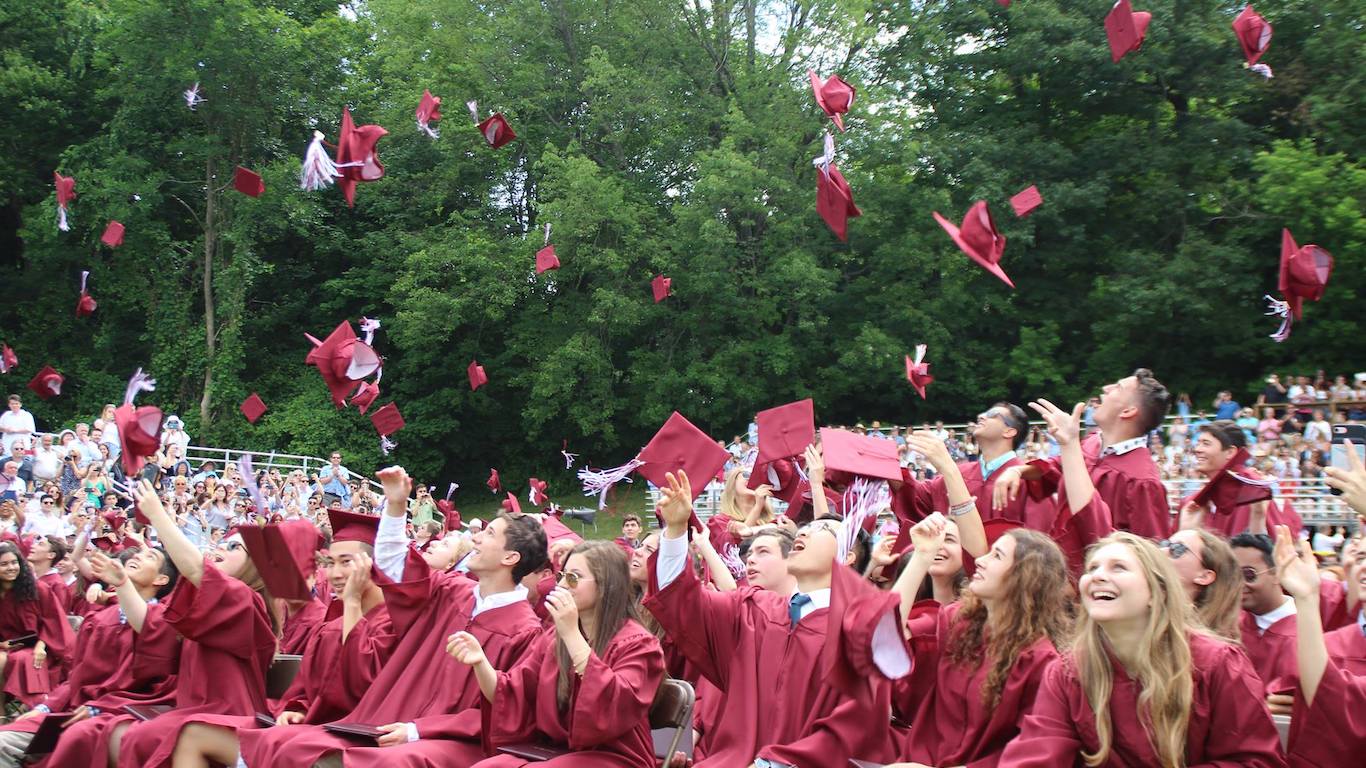
32. New York: Scarsdale Public Schools
> Location: Westchester County
> Annual per student spending: $27,530
> Adults with a bachelor’s degree: 89.5%
With a near-perfect graduation rate of over 97%, the Scarsdale Union Free School District ranks as the best school district in New York state. Across the state as a whole, only 76.0% of high school freshman class students graduate within four years.
Smaller class sizes have been shown to have a generally positive effect on student outcomes. In the Scarsdale district, there are only 12 students per teacher, compared to about 13 statewide and 16.1 nationwide.

33. North Carolina: Chapel Hill-Carrboro City Schools
> Location: Orange County
> Annual per student spending: $12,085
> Adults with a bachelor’s degree: 71.7%
North Carolina’s Chapel Hill-Carrboro City school district is relatively large, with 20 operational schools and over 12,000 students. Spending on education in the district comes to just over $12,000 per student per year, roughly in line with the national average spending per K-12 pupil but well above the state’s spending of $9,072 per pupil.
Like most of the districts on this list, student achievement is very high in Chapel Hill-Carrboro City, with an average SAT score of 1310 and an average ACT score of 30, both well above the national average scores. The share of high school students who have taken at least one AP class is more than double the national share.

34. North Dakota: Kindred School District 2
> Location: Cass County
> Annual per student spending: $9,279
> Adults with a bachelor’s degree: 37.6%
North Dakota’s Kindred School District 2, located just south of Fargo, is a small system of two schools. The best school district in the state, Kindred has a high school graduation rate of at least 90%.
Many of the advantages students in the district have are outside of the classroom. For one, children growing up below the poverty line face unique hardships and stressors that can have a negative impact on academic performance. However, such conditions are rare in the district. Just 5.3% of area children live below the poverty line, about half the 9.5% child poverty rate across North Dakota.
[in-text-ad-2]

35. Ohio: Indian Hill Exempted Village School District
> Location: Hamilton County
> Annual per student spending: $17,407
> Adults with a bachelor’s degree: 76.0%
Ohio’s Indian Hill school district ranks as the best in the state based on our index of student opportunity for success. The district has one of the lower child poverty rates in the country as well as one of the higher high school graduation rates. More than three out of every four district adults have at least a bachelor’s degree, one of 50 districts nationwide where that is the case.
Niche ranks the district, which is located in the suburbs of Cincinnati, as the second best in the state and ranks its teacher quality as best in the state.

36. Oklahoma: Deer Creek School District
> Location: Oklahoma County
> Annual per student spending: $6,819
> Adults with a bachelor’s degree: 61.6%
Per pupil annual spending in Oklahoma’s Deer Creek public school district is $6,819 — lower than any other district on this list and even slightly lower than the state’s relatively low per pupil spending of $7,940, on average.
However, the district still ranks as best in the state as other components in the index compensate for the low funding. The district has a near perfect high school graduation rate, one of the very few school districts in the country where that is the case. It also has a child poverty rate of just 5.4%, which is far less than the statewide child poverty rate of 19.4%.
[in-text-ad]
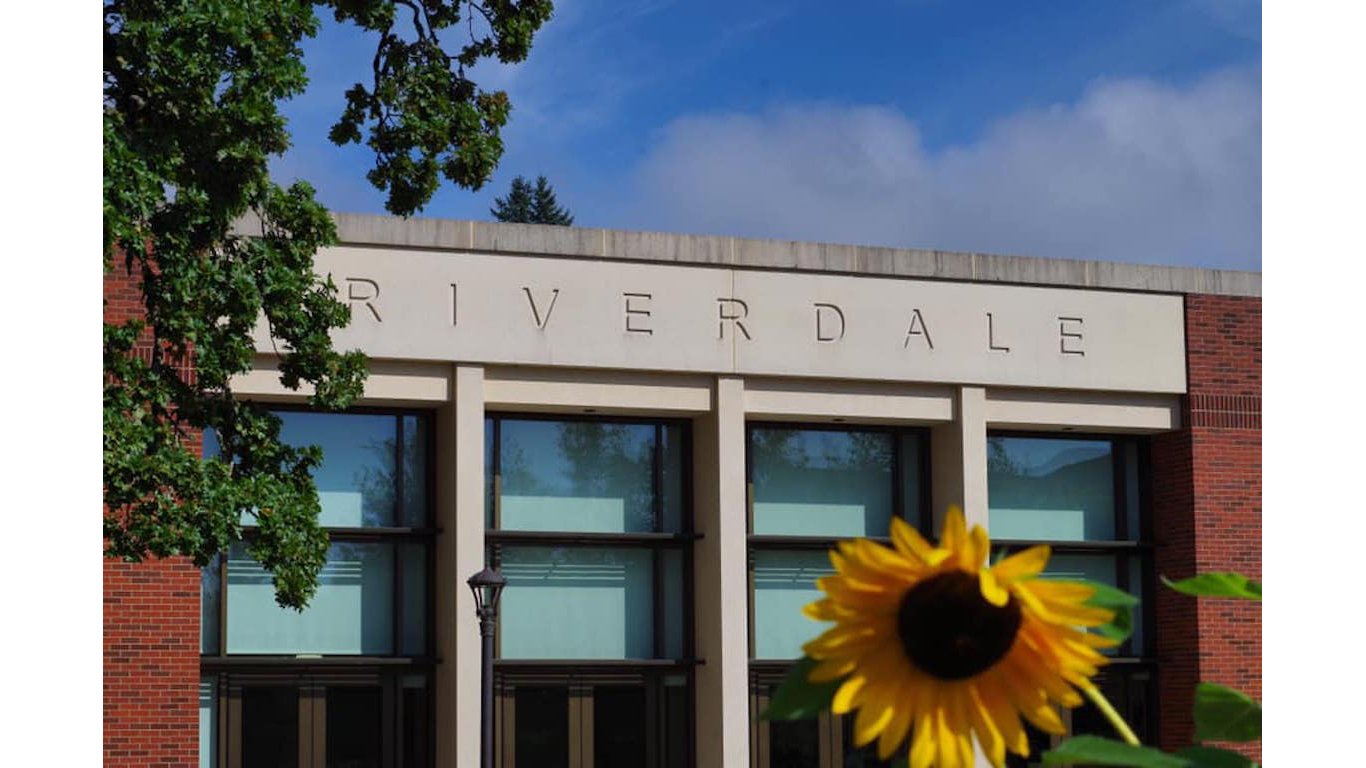
37. Oregon: Riverdale School District
> Location: Multnomah County
> Annual per student spending: $14,444
> Adults with a bachelor’s degree: 82.3%
Oregon’s Riverdale School District is a small district of just two schools and 600 students in the Portland area. Students in the district have several academic advantages both in and out of the classroom. One advantage is higher than average financial resources. Per pupil spending in the district amounts to $14,444 a year, well above the average of $11,264 across the state.
District students are also more likely than most American students to have college-educated parents. Children of parents with a four-year degree are more likely to excel academically, and 82.3% of adults living in the school district’s boundaries have a bachelor’s degree or higher, well above the 32.9% share of adults across the state.
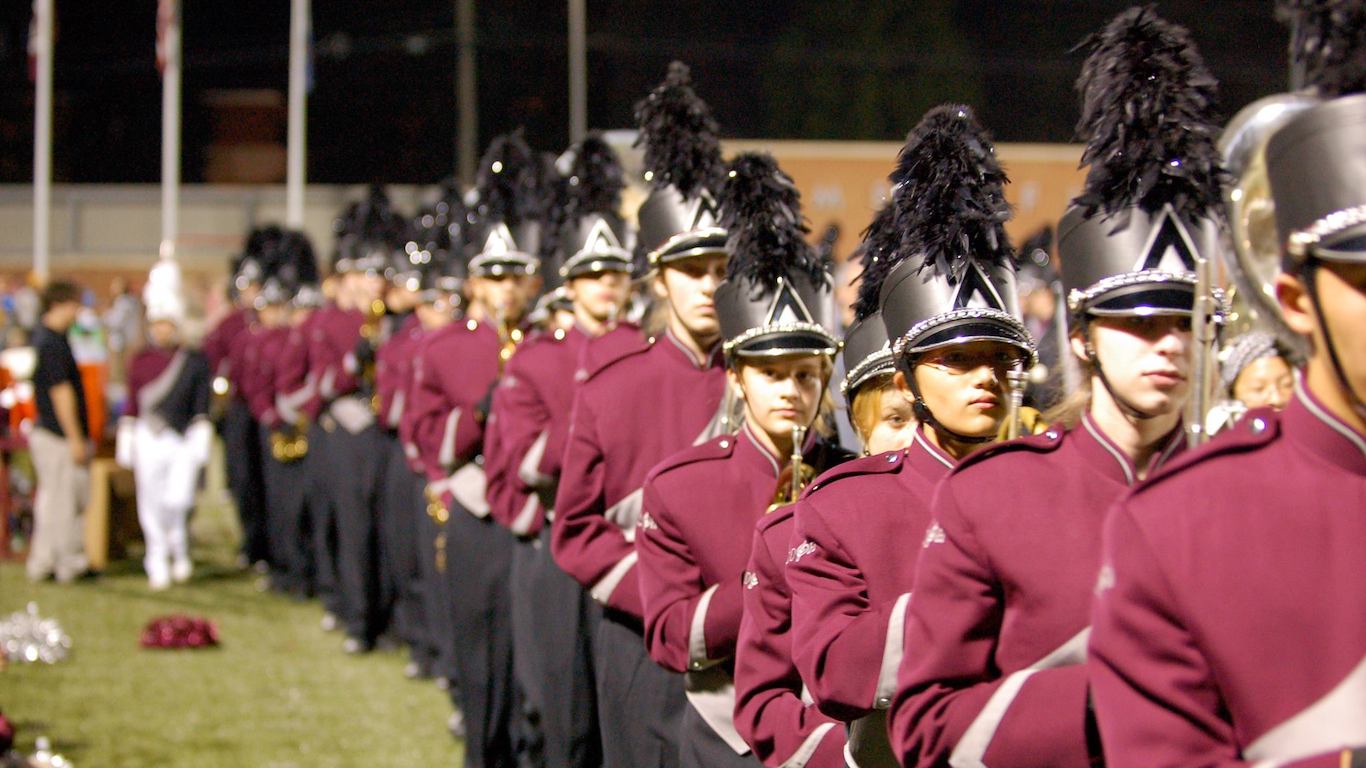
38. Pennsylvania: Tredyffrin-Easttown School District
> Location: Chester County
> Annual per student spending: $17,260
> Adults with a bachelor’s degree: 78.8%
Per student public school spending in Pennsylvania is $15,798 per year, well above the comparable national spending of $12,201. In the Tredyffrin-Easttown School District, schools have even greater financial resources, spending $17,260 per pupil annually.
Advantages in the district are not limited to the classroom. Serious financial hardship in a household can cause stress that has been shown to detract from academic performance. In the Tredyffrin-Easttown School District, however, just 2.9% of children live below the poverty line, a fraction of the 15.5% statewide child poverty rate.

39. Rhode Island: Barrington Public Schools
> Location: Bristol County
> Annual per student spending: $14,371
> Adults with a bachelor’s degree: 68.1%
Students in Rhode Island’s Barrington Public Schools are among the most likely in the country to find academic success, based on the measures included in our index. The district has one of the lowest child poverty rates and among the highest adult college attainment and high school graduation rates in the country.
As is often the case for districts on this list, Barrington is a relatively affluent district, with a median household income of $123,021. About one in four households have an annual income of $200,000 or more.
[in-text-ad-2]

40. South Carolina: Fort Mill School District
> Location: York County
> Annual per student spending: $9,063
> Adults with a bachelor’s degree: 48.4%
South Carolina’s Fort Mill School District is in York County in the northernmost part of the state, on the outskirts of the Charlotte, North Carolina, metro area. By many measures, the district ranks as a one where students have a high chance for success. It has a more than 90% high school graduation rate, as well as a high adult college attainment rate and a low child poverty rate.

41. South Dakota: Harrisburg School District
> Location: Lincoln County
> Annual per student spending: $8,910
> Adults with a bachelor’s degree: 43.6%
South Dakota’s Harrisburg School District, which comprises nine schools and about 4,200 students, ranks as the best in the state, largely due to conditions outside of the classroom. For one, just 2.6% of children in the district live below the poverty line, a fraction of the 14.3% statewide child poverty rate — and serious financial hardship in a household can cause stress that has been shown to detract from academic performance.
Additionally, children of parents with a four-year degree are more likely to excel academically, and 43.6% of adults living in the school district’s boundaries have a bachelor’s degree or higher, well above the share of 28.5% of adults across the state
[in-text-ad]

42. Tennessee: Williamson County Schools
> Location: Williamson County
> Annual per student spending: $9,028
> Adults with a bachelor’s degree: 61.0%
Tennessee’s Williamson County Schools district is one of the largest on this list, with over 38,000 students and 44 operational schools. While the district’s per pupil spending of $9,028 is below the national average spending figure, the district ranks as one of the best in the country in measures of student success and opportunity for success. The district’s high school graduation rate is an estimated 92%, and just 2.7% of children in the district live in poverty, compared to 17.0% of children nationwide.

43. Texas: Highland Park Independent School District
> Location: Dallas County
> Annual per student spending: $9,536
> Adults with a bachelor’s degree: 86.3%
Growing up in a household with college-educated parents can have a significant positive impact on a student’s chances for academic success. In the Highland Park school district, 86.3% of adults have a bachelor’s degree, the fourth highest share of any school district in the country.
Student academic achievement in the district, which is part of the Dallas metropolitan area, is extremely high. Among the district’s roughly 7,000 students, 97% test as proficient in reading, and 98% test as proficient in math. The district’s average SAT score is 1310 and the average ACT score is 30, both well above the national average scores.

44. Utah: Park City School District
> Location: Summit County
> Annual per student spending: $11,368
> Adults with a bachelor’s degree: 66.0%
Park City school district in Utah spends $11,368 per student a year, a slightly lower figure than the national average spending of $12,201 per pupil but well above the state’s spending of $7,179 per student — the nation’s lowest. Like many of the districts on this list, Park City has a highly affluent population, with a median household income of $119,523, nearly double the national figure. An estimated 28% of households have an income of at least $200,000, four times the national share.
[in-text-ad-2]
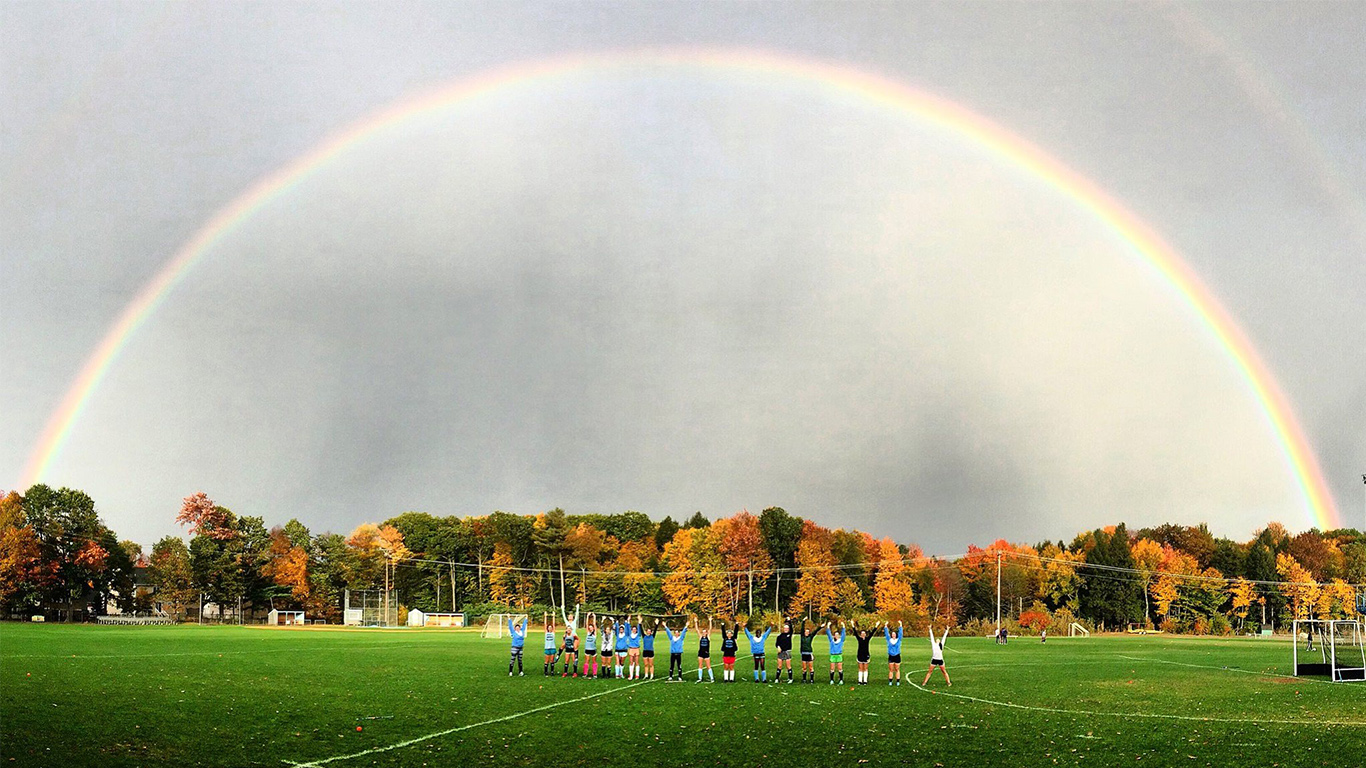
45. Vermont: South Burlington School District
> Location: Chittenden County
> Annual per student spending: $19,638
> Adults with a bachelor’s degree: 55.4%
By many measures, Vermont’s South Burlington City School District ranks as one of the best school districts in the country. The District has an estimated 92% graduation rate, per pupil spending of close to $20,000 annually, and an adult bachelor’s attainment rate of 55.4% — all among the higher figures of any district in any state.
Niche ranks South Burlington City as the second best school district in Vermont and the second best district to teach in the state.
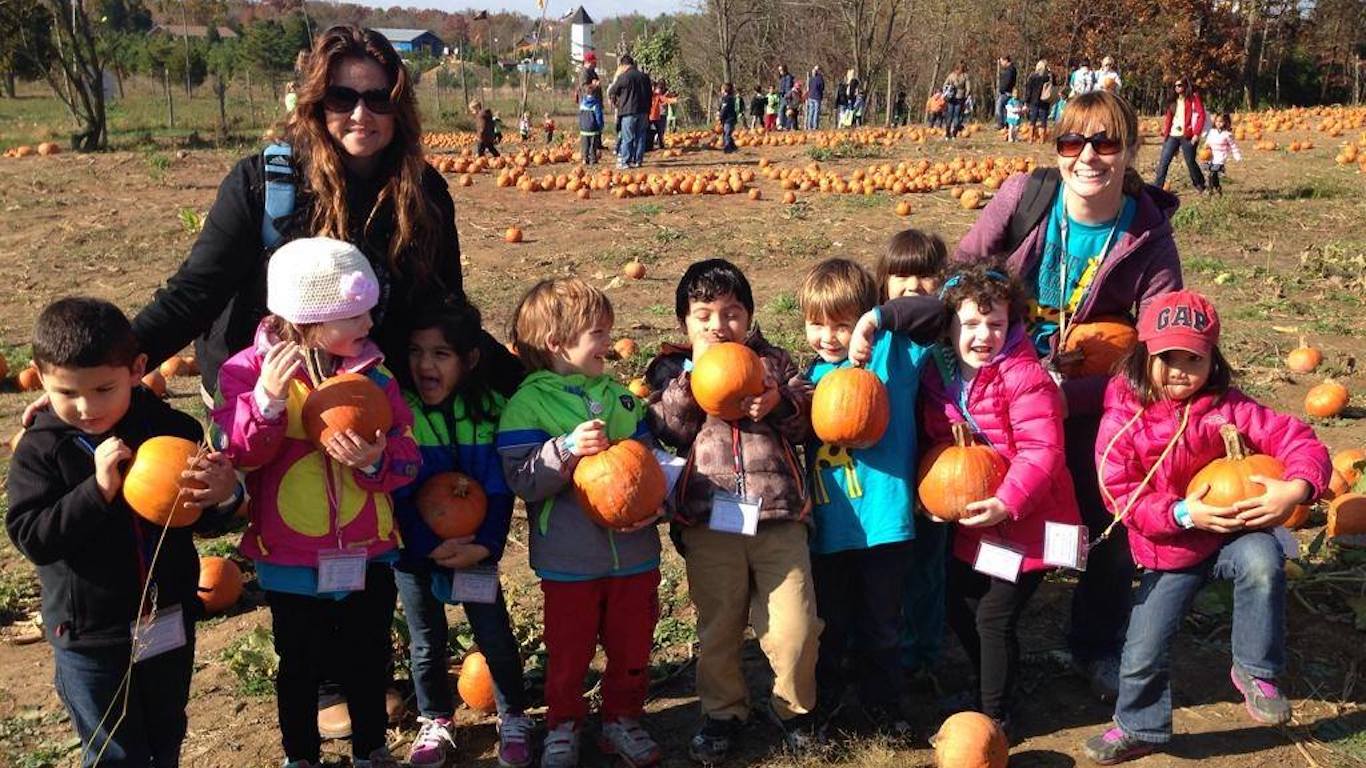
46. Virginia: Falls Church City Schools
> Location: Falls Church City
> Annual per student spending: $17,592
> Adults with a bachelor’s degree: 78.5%
The Falls Church City School District lies within the independent city of Falls Church in northern Virginia. The district has an effectively perfect high school graduation rate, and area students benefit from a relatively large budget and small class sizes. THe district spends $17,592 per student a year, far more than the state average spending of $11,886. Additionally, there are only 14.3 students per teacher in the district, below the state average student-to-teacher ratio of 15.0 to 1 and the national average ratio of 16.1 to 1.
[in-text-ad]

47. Washington: Mercer Island School District
> Location: King County
> Annual per student spending: $12,145
> Adults with a bachelor’s degree: 79.0%
Mercer Island School District is located in the southern end of Lake Washington, just outside of Seattle. While per student school spending and the average student-to-teacher ratio in the district are closely in line with the statewide averages, advantages for children in the district are largely outside of the classroom. For example, children of college-educated parents are more likely than average to be successful academically, and in the Mercer Island district, 79.0% of adults have a bachelor’s degree or higher, the largest share of any district in the state and well above the 35.3% bachelor’s degree attainment rate across Washington.
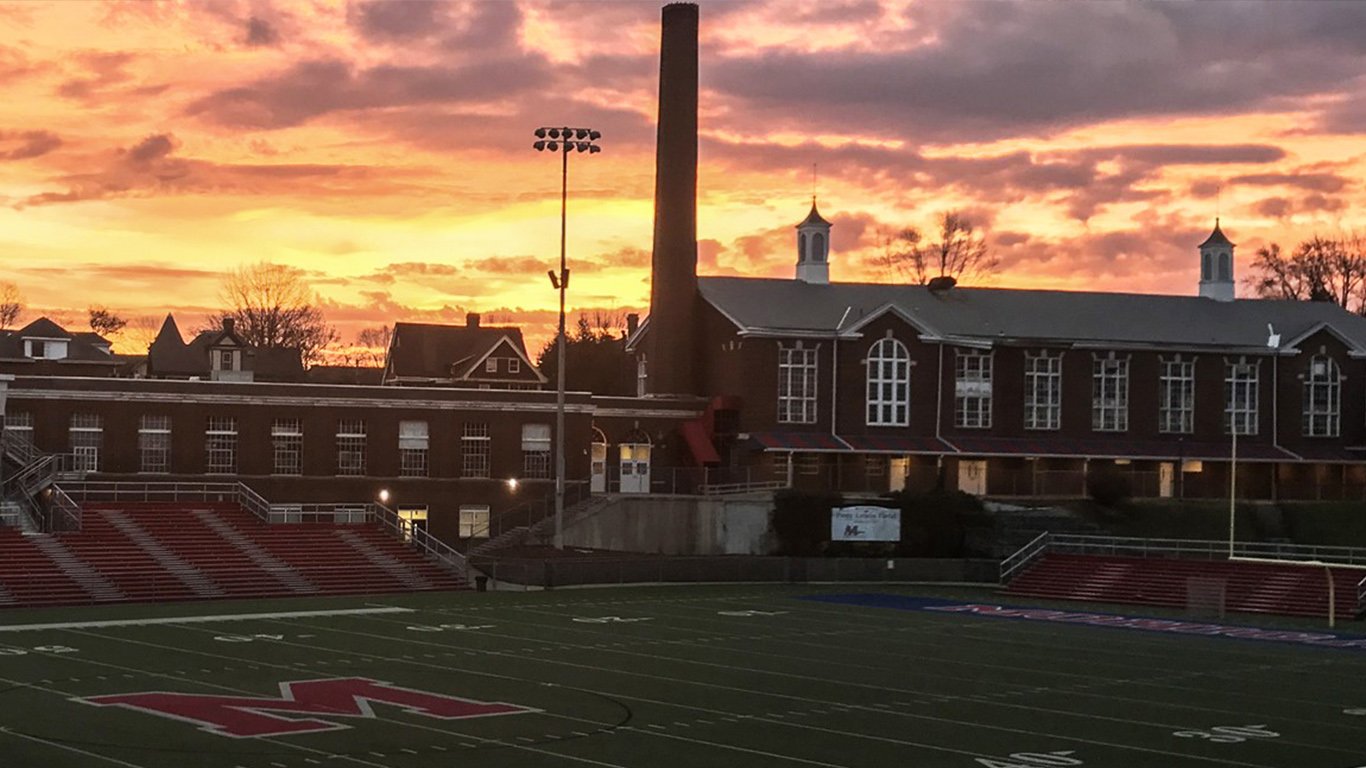
48. West Virginia: Monongalia County Schools
> Location: Monongalia County
> Annual per student spending: $11,357
> Adults with a bachelor’s degree: 41.3%
West Virignia’s Monongalia County School District is relatively large, encompassing 19 operational schools that enroll about 11,500 students. Children of college-educated parents are more likely than most to succeed academically, and in the district, 41.3% of adults have a bachelor’s degree or higher, the largest share of any district in the state and more than double the 20.3% of adults across West Virginia.
Students in the district are also more likely than students across the state to take college level courses while still in high school and master the material. Some 28.2% of district high schoolers are enrolled in an AP class, and 67.6% of those who took one or more AP exam passed at least one of them — each well above the corresponding 14.0% and 49.2% statewide rates.
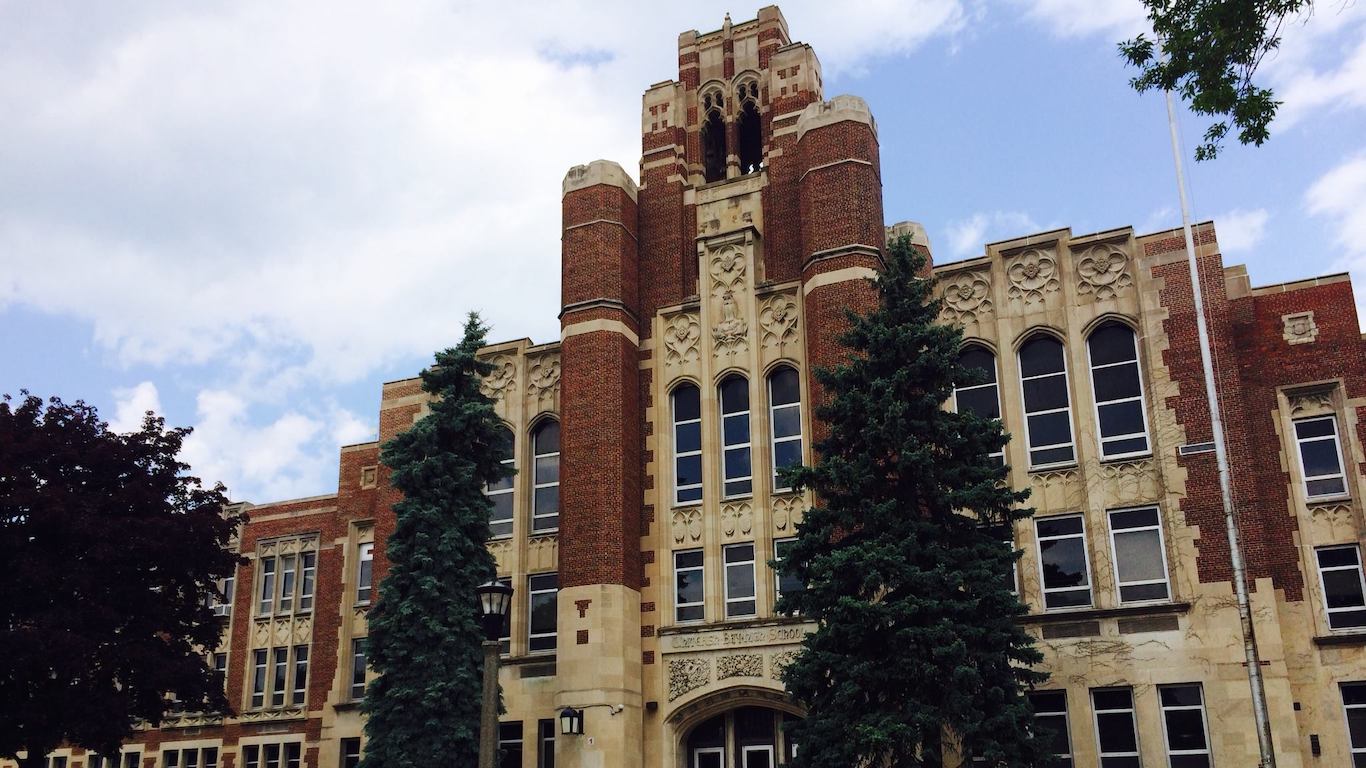
49. Wisconsin: Whitefish Bay School District
> Location: Milwaukee County
> Annual per student spending: $10,222
> Adults with a bachelor’s degree: 75.4%
Wisconsin’s Whitefish Bay School District, located just north of Milwaukee, has a near perfect high school graduation rate. High school students in the district are also more likely to take college level courses and understand the material than the typical high schooler in Wisconsin. Some 31.3% of high schoolers in the district are enrolled in an AP class, and 89.4% of them pass their AP exams — each well above the corresponding 23.1% and 67.4% statewide rates.
[in-text-ad-2]

50. Wyoming: Teton County School District
> Location: Teton County
> Annual per student spending: $17,780
> Adults with a bachelor’s degree: 57.4%
Wyoming’s Teton County School District covers nine schools that enroll nearly 3,000 students in the northwestern section of the state. Smaller class sizes have been shown to have a positive impact on academic performance, and in Teton County, there are an average of 12.5 students per teacher, below both the average student-to-teacher ratios of 12.9 to 1 statewide and 16.1 to 1 nationwide.
The Teton County district also has a higher than average graduation rate. Over 85% of ninth graders graduate high school within four years, compared to about eight in every 10 across Wyoming.
Methodology
To determine the school district where students are most likely to succeed in every state, 24/7 Wall St. developed an index based on various measures of school finance, student success, and other socioeconomic measures. Data on per pupil spending in 2017 came from the U.S. Census Bureau’s Annual Survey of School System Finances and was included in the index. Data on the ratio of students to teachers in the 2017-2018 school year came from the National Center for Education Statistics and was included in the index. The average freshman graduation rate for the 2009-2010 school year also came from the NCES and was included in the index. Data on the percentage of children aged 5 to 17 living in poverty in 2018 came from the U.S. Census Bureau’s Small Area Income and Poverty Estimates program and was included in the index. Finally, five-year data on the percentage of adults 25 and over with at least a bachelor’s degree by school district in 2018 came from the U.S. Census Bureau’s American Community Survey and was included in the index. Only school districts with at least 500 students and four of the five data points included in our index were considered.
Data on Advanced Placement enrollment and the percentage of students who took and passed at least one AP exam in the 2015-2016 school year came from the U.S. Department of Education’s Civil Rights Data Collection program and were aggregated from the school level to the district level using only schools with students in grades nine through 12 exclusively.
Want retirement to come a few years earlier than you’d planned? Or are you ready to retire now, but want an extra set of eyes on your finances?
Now you can speak with up to 3 financial experts in your area for FREE. By simply clicking here you can begin to match with financial professionals who can help you build your plan to retire early. And the best part? The first conversation with them is free.
Click here to match with up to 3 financial pros who would be excited to help you make financial decisions.
Thank you for reading! Have some feedback for us?
Contact the 24/7 Wall St. editorial team.